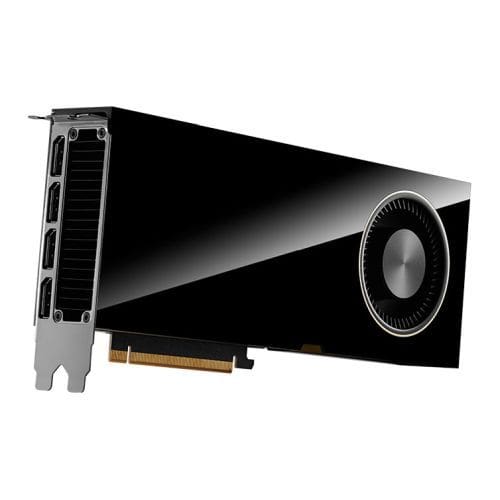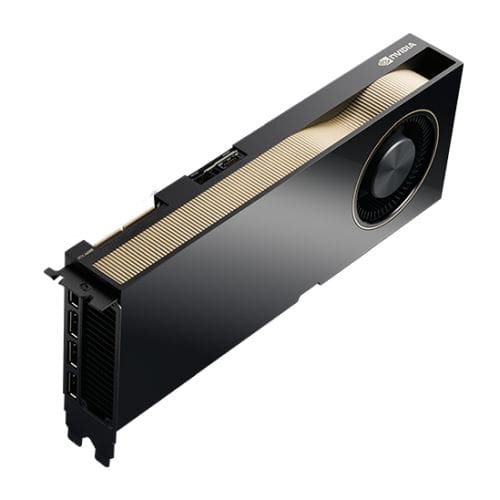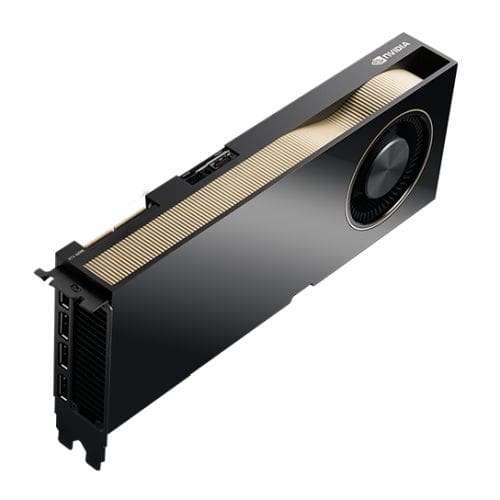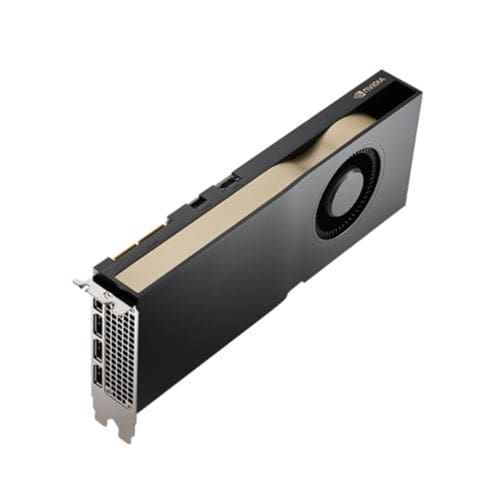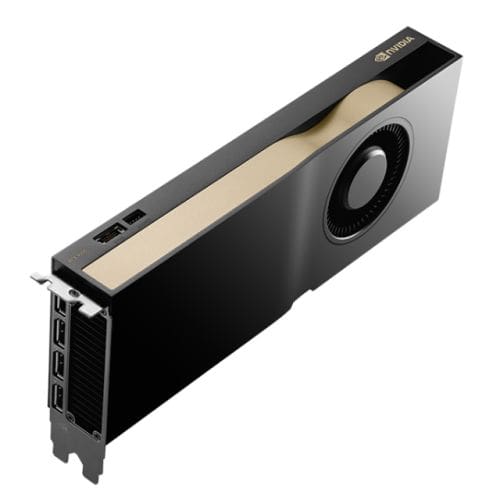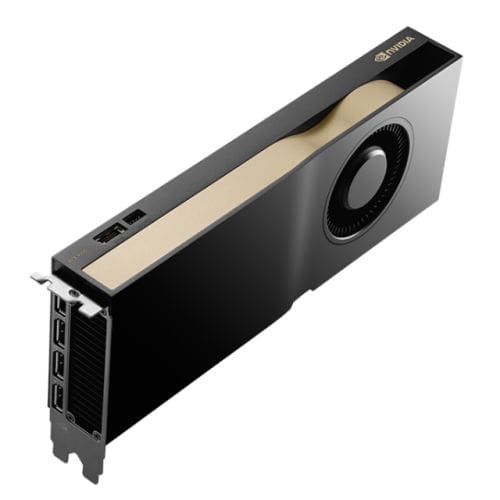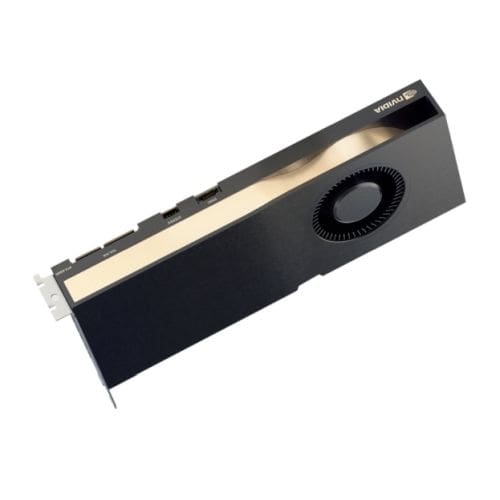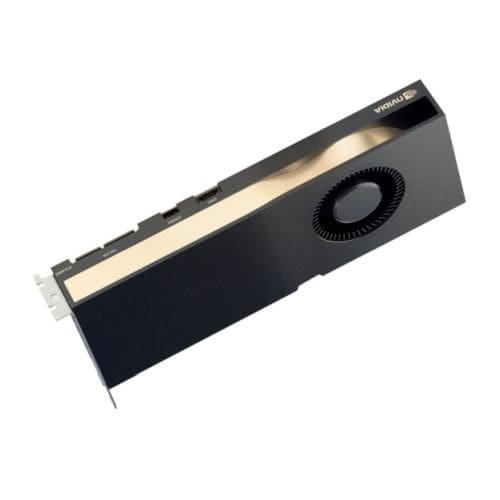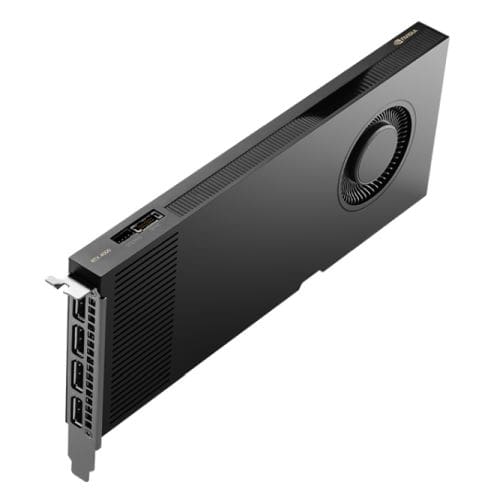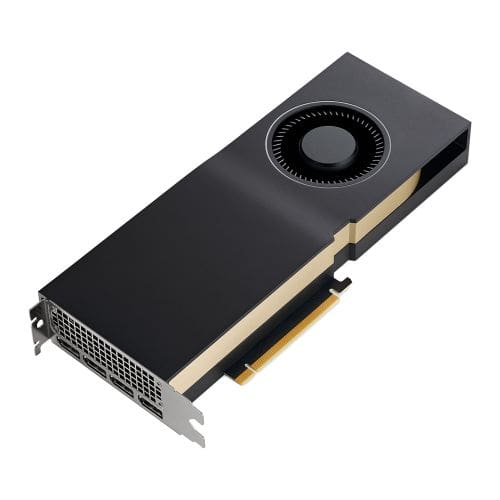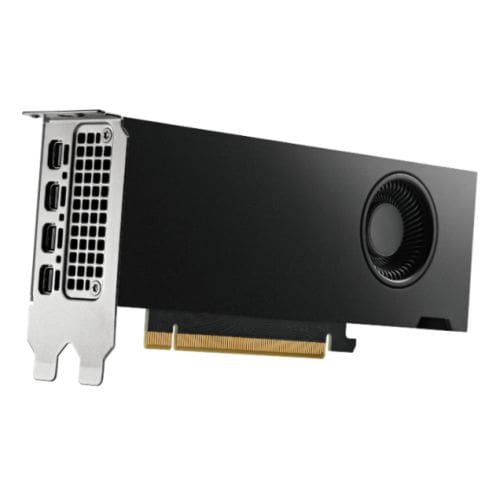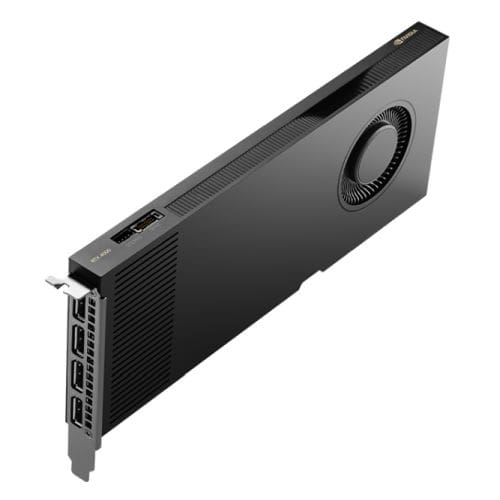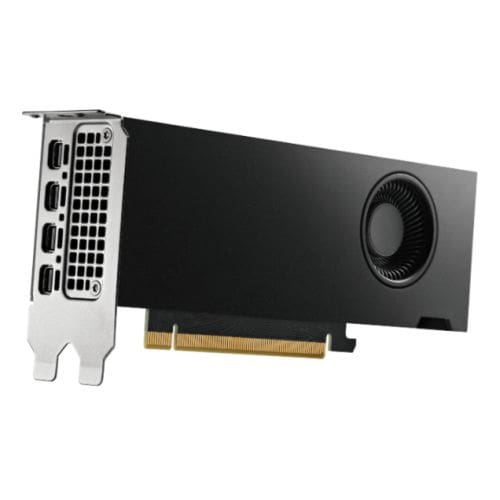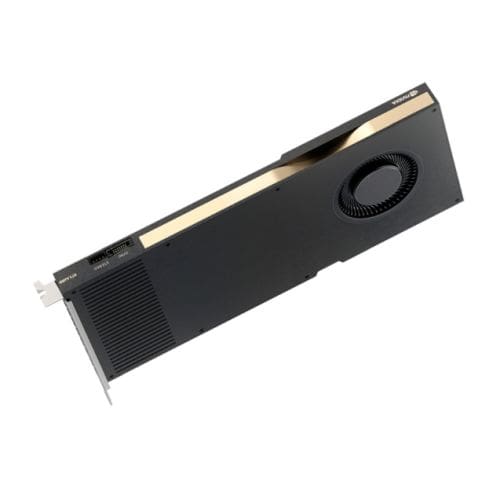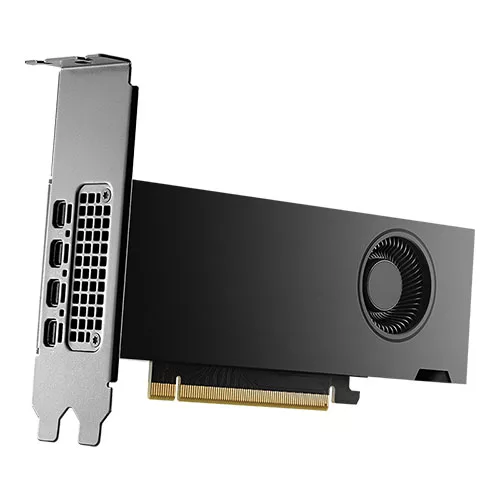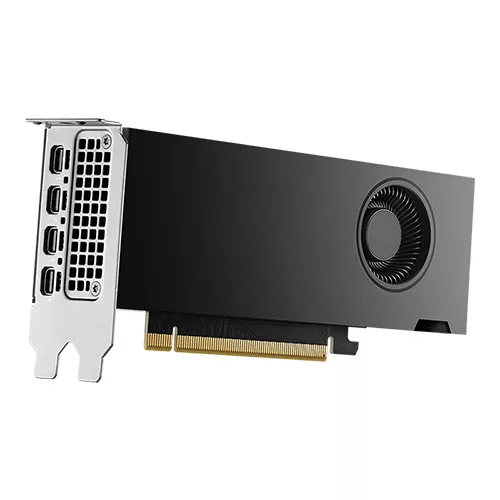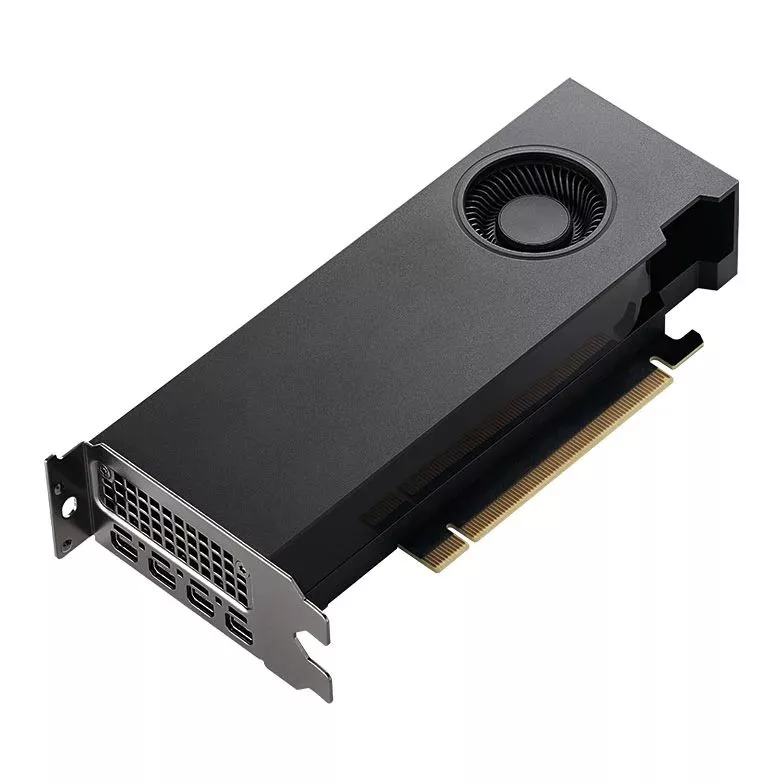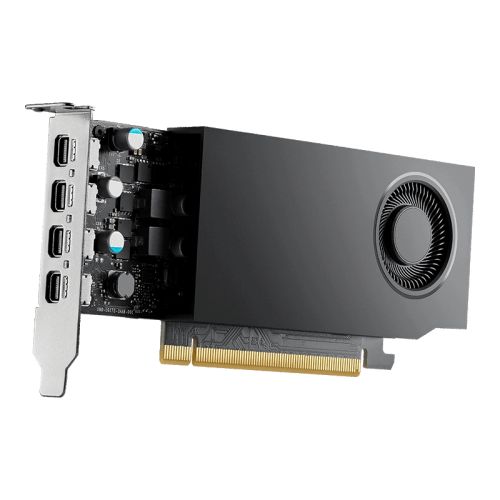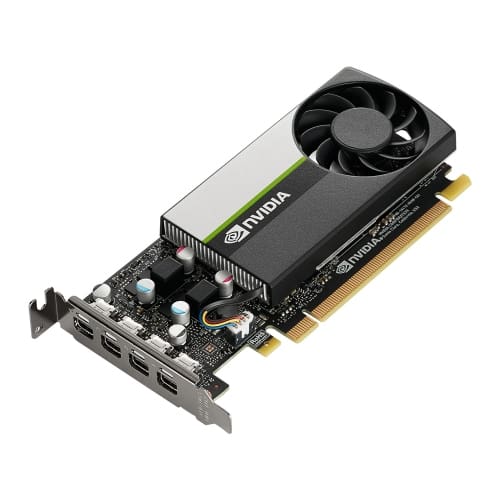PNY
Showing 1–28 of 34 results
-
£7,551.95
Performance For Endless Possibilities
The way people work is undergoing a drastic change with distributed teams and remote workers as the new normal. Artists are facing an ever-increasing demand for differentiated and visually compelling content. Designers and engineers are striving to create more complex and efficient designs in highly supply-constrained environments. Scientists, researchers, and medical professionals are faced with incredible challenges that require the rapid development of solutions on a global scale.The NVIDIA RTX™ 6000 Ada Generation is designed to meet the challenges of today’s professional workflows. Built on the NVIDIA Ada Lovelace architecture, the RTX 6000 combines 142 third-generation RT Cores, 568 fourth-generation Tensor Cores, and 18176 CUDA® cores with 48GB of graphics memory to deliver the next generation of AI graphics and petaflop inferencing performance for unprecedented speed-up of rendering, AI, graphics, and compute workloads. RTX 6000-powered workstations provide what you need to succeed in today’s ultra-challenging business environment.NVIDIA RTX 6000 Ada GenerationThe NVIDIA RTX 6000 Ada combines the highest levels of rendering, visualisation, AI, and compute performance available in a professional graphics card. It provides the capability for massive graphics and visualisation, real-time photorealistic rendering, immersive AR/MR/VR/XR environments, powerful compute, and the creation and deployment of AI solutions.If you need the most powerful real-time rendering, graphics, AR/MR/VR/XR, compute, and deep learning solution available from a professional desktop workstation the NVIDIA RTX 6000 Ada is the ideal board for your professional desktop workstation.NVIDIA Ada Lovelace ArchitectureNVIDIA RTX™ 6000 Ada Generation is the most powerful workstation GPU offering high-performance, real-time ray tracing, AI-accelerated compute, and professional graphics rendering. Building upon the major SM enhancements from the Ada Lovelace GPU, the NVIDIA Ada Lovelace architecture provides more cores, higher clocks, and a larger L2 cache for more performance to enhance ray tracing operations, tensor matrix operations, and frame rates with DLSS 3.0.CUDA CoresThe NVIDIA Ada Lovelace architecture-based CUDA Cores offer more than 2X the single-precision floating point (FP32) throughput compared to the previous generation, providing significant performance improvements for graphics workflows such as 3D model development and compute for workloads such as desktop simulation for computer-aided engineering (CAE). The RTX 6000 Ada enables two FP32 primary data paths, doubling the peak FP32 operations.3rd Generation RT CoresIncorporating 3rd generation ray tracing engines, NVIDIA Ada Lovelace architecture-based GPUs provide incredible ray-traced rendering performance. A single RTX 6000 Ada board can render complex professional models with physically accurate shadows, reflections, and refractions to empower users with instant insight. Working in concert with applications leveraging APIs such as NVIDIA OptiX, Microsoft DXR, and Vulkan ray tracing, systems based on the RTX 6000 Ada will power truly interactive design workflows to provide immediate feedback for unprecedented levels of productivity. The RTX 6000 Ada features up to 2X faster ray-triangle intersection throughput compared to the previous generation.4th Generation Tensor CoresSpecialised for deep learning matrix multiply and accumulate math operations at the heart of neural network training and inferencing functions, the RTX 6000 Ada includes enhanced Tensor Cores that accelerate more data types and still support the Fine-Grained Structured Sparsity feature that delivers more than 2X throughput for tensor matrix operations compared to the previous generation. New Tensor Cores will accelerate new FP8 precision modes. Independent floating-point and integer data paths allow more efficient execution of workloads using a mix of computation and addressing calculations.PCIe Gen 4The RTX 6000 Ada supports PCI Express Gen 4, which provides double the bandwidth of PCIe Gen 3, improving data-transfer speeds from CPU memory for data-intensive tasks like AI and data science.Higher Speed GDDR6 MemoryBuilt with 48GB GDDR6 memory delivering up to 25% greater throughput for ray tracing, rendering, and AI workloads than the previous generation. The RTX 6000 Ada provides the industry's largest graphics memory footprint to address the largest datasets and models in latency-sensitive professional applications.5th Generation NVDEC EngineNVDEC is well suited for transcoding and video playback applications for real-time decoding. The following video codecs are supported for hardware-accelerated decoding: MPEG-2, VC-1, H.264 (AVCHD), H.265 (HEVC), VP8, VP9, and AV1 video formats. Video encoding at 8K/60 will be achievable for professional video editing.8th Generation NVENC EngineNVENC can take on the most demanding 4K or 8K video encoding tasks to free up the graphics engine and the CPU for other operations. The RTX 6000 Ada provides better encoding quality than software-based x264 encoders. The RTX 6000 Ada incorporates AV1 video encoding which is 40% more efficient than H.264 encoding for 4K HDR video. AV1 will provide better quality at the same bitrate bandwidth.Error Correcting Code (ECC) on Graphics MemoryMeet strict data integrity requirements for mission-critical applications with uncompromised computing accuracy and reliability for workstations.Graphics Pre-emptionPixel-level pre-emption provides more granular control to better support time-sensitive tasks such as VR motion tracking.Compute Pre-emptionPre-emption at the instruction level provides finer-grain control over compute tasks to prevent long-running applications from either monopolising system resources or timing out.NVIDIA SLI® TechnologyLeverage multiple GPUs to dynamically scale graphics performance, enhance image quality, expand display real estate, and assemble a fully virtualised system.NVIDIA Mosaic TechnologyTransparently scale the desktop and applications across up to 4 GPUs and 16 displays from a single workstation while delivering full performance and image quality.DisplayPort 1.4aSupport up to four 5K monitors @ 60Hz, or dual 8K displays @ 60Hz per card. The RTX 6000 Ada supports HDR colour for 4K @ 60Hz for 10/12b HEVC decode and up to 4K @ 60Hz for 10b HEVC encode. Each DisplayPort connector can drive ultra-high resolutions of 4096×2160 @ 120 Hz with 30-bit colour.NVIDIA RTX™ Desktop ManagerGain unprecedented end-user control of the desktop experience for increased productivity in a single large display or multi-display environments, especially in the current age of large, widescreen displays.NVIDIA Quadro Sync IISynchronise the display and image output of up to 32 displays3 from 8 GPUs (connected through two Sync II boards) in a single system, reducing the number of machines needed to create an advanced video visualisation environment.Frame Lock Connector LatchEach frame lock connector is designed with a self-locking retention mechanism to secure its connection with the frame lock cable to provide robust connectivity and maximum productivity.OpenGL Quad Buffered Stereo SupportProvide a smooth and immersive 3D Stereo experience for professional applications.Ultra-High-Resolution Desktop SupportGet more Mosaic topology choices with high-resolution display devices with a 32K Max desktop size.Professional 3D Stereo SynchronisationRobust control of stereo effects through a dedicated connection to directly synchronise 3D stereo hardware to an NVIDIA RTX professional graphics card.1 in stock
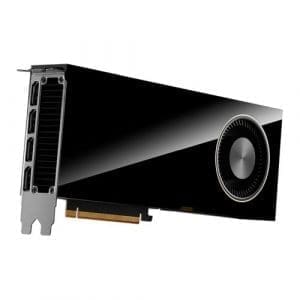
PNY RTXA6000 Ada Lovelace Graphics Card, 48GB DDR6, 4 DP (HDMI adapter), 91.1 TFLOPS SP, 210.6 TFLOPS RT, 1457 TFLOPS Tensor, Retail
£7,551.95 Add to basketQuick View -
£7,103.26
Performance For Endless Possibilities
The way people work is undergoing a drastic change with distributed teams and remote workers as the new normal. Artists are facing an ever-increasing demand for differentiated and visually compelling content. Designers and engineers are striving to create more complex and efficient designs in highly supply-constrained environments. Scientists, researchers, and medical professionals are faced with incredible challenges that require the rapid development of solutions on a global scale.The NVIDIA RTX™ 6000 Ada Generation is designed to meet the challenges of today’s professional workflows. Built on the NVIDIA Ada Lovelace architecture, the RTX 6000 combines 142 third-generation RT Cores, 568 fourth-generation Tensor Cores, and 18176 CUDA® cores with 48GB of graphics memory to deliver the next generation of AI graphics and petaflop inferencing performance for unprecedented speed-up of rendering, AI, graphics, and compute workloads. RTX 6000-powered workstations provide what you need to succeed in today’s ultra-challenging business environment.NVIDIA RTX 6000 Ada GenerationThe NVIDIA RTX 6000 Ada combines the highest levels of rendering, visualisation, AI, and compute performance available in a professional graphics card. It provides the capability for massive graphics and visualisation, real-time photorealistic rendering, immersive AR/MR/VR/XR environments, powerful compute, and the creation and deployment of AI solutions.If you need the most powerful real-time rendering, graphics, AR/MR/VR/XR, compute, and deep learning solution available from a professional desktop workstation the NVIDIA RTX 6000 Ada is the ideal board for your professional desktop workstation.NVIDIA Ada Lovelace ArchitectureNVIDIA RTX™ 6000 Ada Generation is the most powerful workstation GPU offering high-performance, real-time ray tracing, AI-accelerated compute, and professional graphics rendering. Building upon the major SM enhancements from the Ada Lovelace GPU, the NVIDIA Ada Lovelace architecture provides more cores, higher clocks, and a larger L2 cache for more performance to enhance ray tracing operations, tensor matrix operations, and frame rates with DLSS 3.0.CUDA CoresThe NVIDIA Ada Lovelace architecture-based CUDA Cores offer more than 2X the single-precision floating point (FP32) throughput compared to the previous generation, providing significant performance improvements for graphics workflows such as 3D model development and compute for workloads such as desktop simulation for computer-aided engineering (CAE). The RTX 6000 Ada enables two FP32 primary data paths, doubling the peak FP32 operations.3rd Generation RT CoresIncorporating 3rd generation ray tracing engines, NVIDIA Ada Lovelace architecture-based GPUs provide incredible ray-traced rendering performance. A single RTX 6000 Ada board can render complex professional models with physically accurate shadows, reflections, and refractions to empower users with instant insight. Working in concert with applications leveraging APIs such as NVIDIA OptiX, Microsoft DXR, and Vulkan ray tracing, systems based on the RTX 6000 Ada will power truly interactive design workflows to provide immediate feedback for unprecedented levels of productivity. The RTX 6000 Ada features up to 2X faster ray-triangle intersection throughput compared to the previous generation.4th Generation Tensor CoresSpecialised for deep learning matrix multiply and accumulate math operations at the heart of neural network training and inferencing functions, the RTX 6000 Ada includes enhanced Tensor Cores that accelerate more data types and still support the Fine-Grained Structured Sparsity feature that delivers more than 2X throughput for tensor matrix operations compared to the previous generation. New Tensor Cores will accelerate new FP8 precision modes. Independent floating-point and integer data paths allow more efficient execution of workloads using a mix of computation and addressing calculations.PCIe Gen 4The RTX 6000 Ada supports PCI Express Gen 4, which provides double the bandwidth of PCIe Gen 3, improving data-transfer speeds from CPU memory for data-intensive tasks like AI and data science.Higher Speed GDDR6 MemoryBuilt with 48GB GDDR6 memory delivering up to 25% greater throughput for ray tracing, rendering, and AI workloads than the previous generation. The RTX 6000 Ada provides the industry's largest graphics memory footprint to address the largest datasets and models in latency-sensitive professional applications.5th Generation NVDEC EngineNVDEC is well suited for transcoding and video playback applications for real-time decoding. The following video codecs are supported for hardware-accelerated decoding: MPEG-2, VC-1, H.264 (AVCHD), H.265 (HEVC), VP8, VP9, and AV1 video formats. Video encoding at 8K/60 will be achievable for professional video editing.8th Generation NVENC EngineNVENC can take on the most demanding 4K or 8K video encoding tasks to free up the graphics engine and the CPU for other operations. The RTX 6000 Ada provides better encoding quality than software-based x264 encoders. The RTX 6000 Ada incorporates AV1 video encoding which is 40% more efficient than H.264 encoding for 4K HDR video. AV1 will provide better quality at the same bitrate bandwidth.Error Correcting Code (ECC) on Graphics MemoryMeet strict data integrity requirements for mission-critical applications with uncompromised computing accuracy and reliability for workstations.Graphics Pre-emptionPixel-level pre-emption provides more granular control to better support time-sensitive tasks such as VR motion tracking.Compute Pre-emptionPre-emption at the instruction level provides finer-grain control over compute tasks to prevent long-running applications from either monopolising system resources or timing out.NVIDIA SLI® TechnologyLeverage multiple GPUs to dynamically scale graphics performance, enhance image quality, expand display real estate, and assemble a fully virtualised system.NVIDIA Mosaic TechnologyTransparently scale the desktop and applications across up to 4 GPUs and 16 displays from a single workstation while delivering full performance and image quality.DisplayPort 1.4aSupport up to four 5K monitors @ 60Hz, or dual 8K displays @ 60Hz per card. The RTX 6000 Ada supports HDR colour for 4K @ 60Hz for 10/12b HEVC decode and up to 4K @ 60Hz for 10b HEVC encode. Each DisplayPort connector can drive ultra-high resolutions of 4096×2160 @ 120 Hz with 30-bit colour.NVIDIA RTX™ Desktop ManagerGain unprecedented end-user control of the desktop experience for increased productivity in a single large display or multi-display environments, especially in the current age of large, widescreen displays.NVIDIA Quadro Sync IISynchronise the display and image output of up to 32 displays3 from 8 GPUs (connected through two Sync II boards) in a single system, reducing the number of machines needed to create an advanced video visualisation environment.Frame Lock Connector LatchEach frame lock connector is designed with a self-locking retention mechanism to secure its connection with the frame lock cable to provide robust connectivity and maximum productivity.OpenGL Quad Buffered Stereo SupportProvide a smooth and immersive 3D Stereo experience for professional applications.Ultra-High-Resolution Desktop SupportGet more Mosaic topology choices with high-resolution display devices with a 32K Max desktop size.Professional 3D Stereo SynchronisationRobust control of stereo effects through a dedicated connection to directly synchronise 3D stereo hardware to an NVIDIA RTX professional graphics card.3 in stock
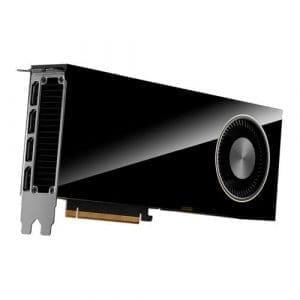
PNY RTXA6000 Ada Lovelace Graphics Card, 48GB DDR6, 4 DP, 91.1 TFLOPS SP, 210.6 TFLOPS RT, 1457 TFLOPS Tensor, OEM (Brown Box)
£7,103.26 Add to basketQuick View -
£4,644.99
Performance for Endless Possibilities
The NVIDIA RTX 5000 Ada Generation is purpose-built for today's professional workflows. Built on the NVIDIA Ada Lovelace architecture, it combines 100 third-generation RT Cores, 400 fourth-generation Tensor Cores, and 12,800 CUDA cores with 32GB of graphics memory to accelerate rendering, AI, graphics, and compute workloads. RTX 5000-powered workstations equip you for success in today's demanding business landscape.Performance And Usability FeaturesNVIDIA Ada Lovelace ArchitectureExperience fast, interactive performance-powered by the latest NVIDIA Ada Lovelace architecture-based GPU-with ultra-fast, onboard graphics memory technology and optimized software drivers for professional applications. The Shader Execution Reordering (SER) system allows on-the-fly organization and reordering of workloads, grouping similar performing threads so the streaming multiprocessor (SM) and RT Core can operate more efficiently.CUDA CoresThe NVIDIA Ada Lovelace architecture-based CUDA cores deliver up to 2X the single-precision floating-point (FP32) throughput compared to the previous generation, providing significant performance improvements for graphics workflows such as 3D model development and compute for workloads like desktop simulation for CAE.Third-Generation RT CoresThird-generation RT Cores provide up to 2X the throughput of the previous generation and the ability to run ray tracing with either shading or denoising capabilities concurrently. This accelerates renders for M&E content creation, AECO design evaluations, and manufacturing virtual prototyping. Third-generation RT Cores deliver up to 2X the ray-tracing performance over the previous generation, delivering groundbreaking performance for photorealistic rendering. Enhanced RT Cores combined with new SER technology dynamically reorder inefficient workloads, dramatically improving shader performance to accelerate end-to-end ray-traced image rendering performance.Fourth-Generation Tensor CoresFourth-generation Tensor Cores provide up to 5X faster AI training performance than the previous generation with FP16 precision. Support for the new FP8 data format for inference provides more than 5X faster performance than the previous generation and reduces data memory usage by half (compared to the FP16 data format).Encode and Decode EnginesRTX 5000 includes two video encode engines and two decode engines, including support for the AV1 video format and the performance required for multi-stream video applications for security and video serving.PCIe Gen 4RTX 5000 supports PCIe Gen4, which doubles the bandwidth of PCIe Gen3 from 15.75GB/s to 31.5GB/s for x16 connections, improving data transfer speeds from CPU memory for data-intensive tasks such as AI, data science, and creating large 3D models and scenes. Faster PCIe performance also accelerates GPU DMA transfers, providing faster video data transfers from GPUDirect for Video-enabled devices and faster IO with GPUDirect Storage.GPU MemoryRTX 5000 features 32GB of GDDR6 memory, providing the memory needed for rendering, data science, engineering simulation, and other GPU memory-intensive applications. With greater memory bandwidth than the previous generation, RTX 5000 can move data between the GPU and GPU memory faster, resulting in better graphics, compute, and rendering performance.Virtualization-ReadySupport for virtualization allows a personal workstation to be repurposed into multiple high-performance virtual workstation instances. This enables remote users to share resources to drive high-end design, AI, and compute workloads.Multi-DisplayFour DisplayPort 1.4a connectors, support for multiple 8K monitors, NVIDIA Quadro Sync, Mosaic, and Warp and Blend enable massive immersive environments for CAVE, video walls, and location-based entertainment deployments.Extended RealitySupport for the latest high-resolution HMD devices, high-performance graphics, and large 32GB of GPU memory enables the creation of incredible AR and VR experiences for training, product validations, building walkthroughs, and compelling entertainment.Form Factor and Power EfficiencyWith a dual-slot, power-efficient design, RTX 5000 fits into a wide range of workstation chassis, providing professionals with a generous selection of compatible workstations from worldwide OEM vendors.Motion BVHHardware-accelerated rendering of motion blur-a common cinematic effect that's difficult to render-means artists no longer need to rely on traditional methods of using motion vectors to achieve motion blur. Motion vectors give the artist flexibility to adjust motion blur in post but require visual fixes for reflections and translucency.NVIDIA DLSS 3.0The Ada Lovelace GPU architecture features a new Optical Flow Accelerator and AI-based DLSS Super Resolution with DL denoiser that boost DLSS 3.0's frame rates up to 4X compared to the previous version while maintaining or exceeding native image quality.NVIDIA RTX Broadcast EngineThe NVIDIA RTX Broadcast Engine transforms offices into broadcast studios, upgrading standard webcams and microphones into premium, smart devices with the power of AI. Improve the video and audio quality of livestreams with AI capabilities such as virtual backgrounds, webcam auto frame, and microphone noise removal. With dedicated AI processors called Tensor Cores on NVIDIA RTX GPUs, the AI networks can run in real time alongside applications.NVIDIA-Certified Systems For Accelerated ComputingNVIDIA RTX 5000 delivers groundbreaking performance for professionals in design, content creation, engineering, research, and data science. RTX 5000 GPUs in NVIDIA-Certified workstations are powered by third-generation RTX technology and enable fast photorealistic, ray-traced rendering, graphics, compute, and AI-accelerated workflows. Certified workstations have been validated to make optimal use of GPUs. Well-balanced designs that account for issues, such as thermal management and PCIe configuration, ensure that system resources are used to their fullest potential.Software SupportNVIDIA RTX ExperienceNVIDIA RTX Experience delivers a suite of productivity tools to your desktop workstation, including desktop recording in up to 8K, automatic alerts for the latest NVIDIA RTX Enterprise driver updates, and access gaming features.NVIDIA CUDA Parallel Computing PlatformNatively execute standard programming languages like C/C++ and Fortran, and APIs such as OpenCL, OpenACC, and Direct Compute to accelerate techniques such as ray tracing, video and image processing, and computation fluid dynamics.Unified MemoryA single, seamless 49-bit virtual address space allows for the transparent migration of data between the full allocation of CPU and GPU memory.NVIDIA GPU Direct for VideoGPUDirect for Video speeds communication between the GPU and video I/O devices by avoiding unnecessary system memory copies and CPU overhead.NVIDIA Enterprise Management ToolsMaximize system uptime, seamlessly manage wide-scale deployments, and remotely control graphics and display settings for efficient operations.Out of stock
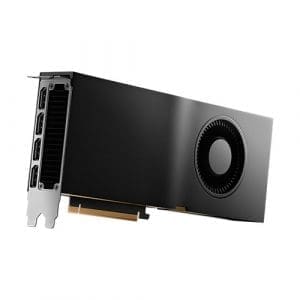
PNY RTX5000 Ada Lovelace Professional Graphics Card, 32GB DDR6, 4 DP (HDMI adapter), 12800 CUDA Cores, Dual-Slot, Retail
£4,644.99 Read moreQuick View -
£4,489.76
Performance for Endless Possibilities
The NVIDIA RTX 5000 Ada Generation is purpose-built for today's professional workflows. Built on the NVIDIA Ada Lovelace architecture, it combines 100 third-generation RT Cores, 400 fourth-generation Tensor Cores, and 12,800 CUDA cores with 32GB of graphics memory to accelerate rendering, AI, graphics, and compute workloads. RTX 5000-powered workstations equip you for success in today's demanding business landscape.Performance And Usability FeaturesNVIDIA Ada Lovelace ArchitectureExperience fast, interactive performance-powered by the latest NVIDIA Ada Lovelace architecture-based GPU-with ultra-fast, onboard graphics memory technology and optimized software drivers for professional applications. The Shader Execution Reordering (SER) system allows on-the-fly organization and reordering of workloads, grouping similar performing threads so the streaming multiprocessor (SM) and RT Core can operate more efficiently.CUDA CoresThe NVIDIA Ada Lovelace architecture-based CUDA cores deliver up to 2X the single-precision floating-point (FP32) throughput compared to the previous generation, providing significant performance improvements for graphics workflows such as 3D model development and compute for workloads like desktop simulation for CAE.Third-Generation RT CoresThird-generation RT Cores provide up to 2X the throughput of the previous generation and the ability to run ray tracing with either shading or denoising capabilities concurrently. This accelerates renders for M&E content creation, AECO design evaluations, and manufacturing virtual prototyping. Third-generation RT Cores deliver up to 2X the ray-tracing performance over the previous generation, delivering groundbreaking performance for photorealistic rendering. Enhanced RT Cores combined with new SER technology dynamically reorder inefficient workloads, dramatically improving shader performance to accelerate end-to-end ray-traced image rendering performance.Fourth-Generation Tensor CoresFourth-generation Tensor Cores provide up to 5X faster AI training performance than the previous generation with FP16 precision. Support for the new FP8 data format for inference provides more than 5X faster performance than the previous generation and reduces data memory usage by half (compared to the FP16 data format).Encode and Decode EnginesRTX 5000 includes two video encode engines and two decode engines, including support for the AV1 video format and the performance required for multi-stream video applications for security and video serving.PCIe Gen 4RTX 5000 supports PCIe Gen4, which doubles the bandwidth of PCIe Gen3 from 15.75GB/s to 31.5GB/s for x16 connections, improving data transfer speeds from CPU memory for data-intensive tasks such as AI, data science, and creating large 3D models and scenes. Faster PCIe performance also accelerates GPU DMA transfers, providing faster video data transfers from GPUDirect for Video-enabled devices and faster IO with GPUDirect Storage.GPU MemoryRTX 5000 features 32GB of GDDR6 memory, providing the memory needed for rendering, data science, engineering simulation, and other GPU memory-intensive applications. With greater memory bandwidth than the previous generation, RTX 5000 can move data between the GPU and GPU memory faster, resulting in better graphics, compute, and rendering performance.Virtualization-ReadySupport for virtualization allows a personal workstation to be repurposed into multiple high-performance virtual workstation instances. This enables remote users to share resources to drive high-end design, AI, and compute workloads.Multi-DisplayFour DisplayPort 1.4a connectors, support for multiple 8K monitors, NVIDIA Quadro Sync, Mosaic, and Warp and Blend enable massive immersive environments for CAVE, video walls, and location-based entertainment deployments.Extended RealitySupport for the latest high-resolution HMD devices, high-performance graphics, and large 32GB of GPU memory enables the creation of incredible AR and VR experiences for training, product validations, building walkthroughs, and compelling entertainment.Form Factor and Power EfficiencyWith a dual-slot, power-efficient design, RTX 5000 fits into a wide range of workstation chassis, providing professionals with a generous selection of compatible workstations from worldwide OEM vendors.Motion BVHHardware-accelerated rendering of motion blur-a common cinematic effect that's difficult to render-means artists no longer need to rely on traditional methods of using motion vectors to achieve motion blur. Motion vectors give the artist flexibility to adjust motion blur in post but require visual fixes for reflections and translucency.NVIDIA DLSS 3.0The Ada Lovelace GPU architecture features a new Optical Flow Accelerator and AI-based DLSS Super Resolution with DL denoiser that boost DLSS 3.0's frame rates up to 4X compared to the previous version while maintaining or exceeding native image quality.NVIDIA RTX Broadcast EngineThe NVIDIA RTX Broadcast Engine transforms offices into broadcast studios, upgrading standard webcams and microphones into premium, smart devices with the power of AI. Improve the video and audio quality of livestreams with AI capabilities such as virtual backgrounds, webcam auto frame, and microphone noise removal. With dedicated AI processors called Tensor Cores on NVIDIA RTX GPUs, the AI networks can run in real time alongside applications.NVIDIA-Certified Systems For Accelerated ComputingNVIDIA RTX 5000 delivers groundbreaking performance for professionals in design, content creation, engineering, research, and data science. RTX 5000 GPUs in NVIDIA-Certified workstations are powered by third-generation RTX technology and enable fast photorealistic, ray-traced rendering, graphics, compute, and AI-accelerated workflows. Certified workstations have been validated to make optimal use of GPUs. Well-balanced designs that account for issues, such as thermal management and PCIe configuration, ensure that system resources are used to their fullest potential.Software SupportNVIDIA RTX ExperienceNVIDIA RTX Experience delivers a suite of productivity tools to your desktop workstation, including desktop recording in up to 8K, automatic alerts for the latest NVIDIA RTX Enterprise driver updates, and access gaming features.NVIDIA CUDA Parallel Computing PlatformNatively execute standard programming languages like C/C++ and Fortran, and APIs such as OpenCL, OpenACC, and Direct Compute to accelerate techniques such as ray tracing, video and image processing, and computation fluid dynamics.Unified MemoryA single, seamless 49-bit virtual address space allows for the transparent migration of data between the full allocation of CPU and GPU memory.NVIDIA GPU Direct for VideoGPUDirect for Video speeds communication between the GPU and video I/O devices by avoiding unnecessary system memory copies and CPU overhead.NVIDIA Enterprise Management ToolsMaximize system uptime, seamlessly manage wide-scale deployments, and remotely control graphics and display settings for efficient operations.Out of stock

PNY RTX5000 Ada Lovelace Professional Graphics Card, 32GB DDR6, 4 DP, 12800 CUDA Cores, Dual-Slot, OEM (Brown Box)
£4,489.76 Read moreQuick View -
£4,304.76
Performance Amplified
The world of professional visualization is evolving rapidly. Advanced requirements like real-time ray tracing, AI, compute, engineering simulation, and immersive VR are common across industries, while millions of professionals have shifted to working from home.The NVIDIA RTX A6000 delivers everything designers, engineers, and artists need to meet today's demands from their desktop. Built on the NVIDIA Ampere architecture, the RTX A6000 combines 84 second-generation RT Cores, 336 third-generation Tensor Cores, and 10,752 CUDA cores with 48 GB of graphics memory for unprecedented rendering, AI, graphics, and compute performance. Connect two RTX A6000s with NVIDIA NVLink™ for 96 GB of combined GPU memory. And access the power of your workstation from anywhere with remote-access software. Engineer amazing products, design state-of-the art buildings, drive scientific breakthroughs, and create immersive entertainment with the world's most powerful graphics solution.NVIDIA Ampere ArchitectureNVIDIA RTX A6000 is the most powerful workstation GPU NVIDIA offering high performance real-time ray tracing, AI-accelerated compute, and professional graphics rendering. Building upon the major SM enhancements from the Turing GPU, the NVIDIA Ampere architecture enhances ray tracing operations, tensor matrix operations, and concurrent executions of FP32 and INT32 operations.CUDA CoresThe NVIDIA Ampere architecture-based CUDA cores bring up to 2X the single-precision floating point (FP32) throughput compared to the previous generation, providing significant performance improvements for graphics workflows such as 3D model development and compute for workloads such as desktop simulation for computer-aided engineering (CAE). The RTX A6000 enables two FP32 primary data paths, doubling the peak FP32 operations.Second Generation RT CoresIncorporating second generation ray tracing engines, NVIDIA Ampere architecture-based GPUs provide incredible ray traced rendering performance. A single RTX A6000 board can render complex professional models with physically accurate shadows, reflections, and refractions to empower users with instant insight. Working in concert with applications leveraging APIs such as NVIDIA OptiX, Microsoft DXR and Vulkan ray tracing, systems based on the RTX A6000 will power truly interactive design workflows to provide immediate feedback for unprecedented levels of productivity. The RTX A6000 is up to 2X faster in ray tracing compared to the previous generation. This technology also speeds up the rendering of ray-traced motion blur for faster results with greater visual accuracy.Third Generation Tensor CoresPurpose-built for deep learning matrix arithmetic at the heart of neural network training and inferencing functions, the RTX A6000 includes enhanced Tensor Cores that accelerate more datatypes, and includes a new Fine-Grained Structured Sparsity feature that delivers up to 2X throughput for tensor matrix operations compared to the previous generation. New Tensor Cores will accelerate two new TF32 and BFloat16 precision modes. Independent floating-point and integer data paths allow more efficient execution of workloads using a mix of computation and addressing calculations.PCIe Gen 4The RTX A6000 supports PCI Express Gen 4, which provides double the bandwidth of PCIe Gen 3, improving data-transfer speeds from CPU memory for data-intensive tasks like AI and data science.Higher Speed GDDR6 MemoryBuilt with 48GB GDDR6 memory delivering up to 15% greater throughput for ray tracing, rendering, and AI workloads than the previous generation. The RTX A6000 provides the industry’s largest graphics memory footprint to address the largest datasets and models in latency-sensitive professional applications.Error Correcting Code (ECC) on Graphics MemoryMeet strict data integrity requirements for mission critical applications with uncompromised computing accuracy and reliability for workstations.Fifth Generation NVDEC EngineNVDEC is well suited for transcoding and video playback applications for real-time decoding. The following video codecs are supported for hardware-accelerated decoding: MPEG-2, VC-1, H.264 (AVCHD), H.265 (HEVC), VP8, VP9, and AV1.Seventh Generation NVENC EngineNVENC can take on the most demanding 4K or 8K video encoding tasks to free up the graphics engine and the CPU for other operations. The RTX A6000 provides better encoding quality than software-based x264 encoders.Graphics PreemptionPixel-level preemption provides more granular control to better support time-sensitive tasks such as VR motion tracking.Compute PreemptionPreemption at the instruction-level provides finer grain control over compute tasks to prevent long-running applications from either monopolizing system resources or timing out.NVIDIA RTX IOAccelerating GPU-based lossless decompression performance by up to 100x and 20x lower CPU utilization compared to traditional storage APIs using Microsoft’s new DirectStorage for Windows API. RTX IO moves data from the storage to the GPU in a more efficient, compressed form, and improving I/O performance.3 in stock
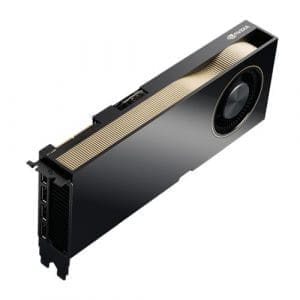
PNY RTXA6000 Professional Graphics Card, 48GB DDR6, 4 DP (HDMI adapter), Ampere Ray Tracing, 10752 Core, NVLink support, Retail
£4,304.76 Add to basketQuick View -
£4,251.31
Performance Amplified
The world of professional visualization is evolving rapidly. Advanced requirements like real-time ray tracing, AI, compute, engineering simulation, and immersive VR are common across industries, while millions of professionals have shifted to working from home.The NVIDIA RTX A6000 delivers everything designers, engineers, and artists need to meet today's demands from their desktop. Built on the NVIDIA Ampere architecture, the RTX A6000 combines 84 second-generation RT Cores, 336 third-generation Tensor Cores, and 10,752 CUDA cores with 48 GB of graphics memory for unprecedented rendering, AI, graphics, and compute performance. Connect two RTX A6000s with NVIDIA NVLink™ for 96 GB of combined GPU memory. And access the power of your workstation from anywhere with remote-access software. Engineer amazing products, design state-of-the art buildings, drive scientific breakthroughs, and create immersive entertainment with the world's most powerful graphics solution.NVIDIA Ampere ArchitectureNVIDIA RTX A6000 is the most powerful workstation GPU NVIDIA offering high performance real-time ray tracing, AI-accelerated compute, and professional graphics rendering. Building upon the major SM enhancements from the Turing GPU, the NVIDIA Ampere architecture enhances ray tracing operations, tensor matrix operations, and concurrent executions of FP32 and INT32 operations.CUDA CoresThe NVIDIA Ampere architecture-based CUDA cores bring up to 2X the single-precision floating point (FP32) throughput compared to the previous generation, providing significant performance improvements for graphics workflows such as 3D model development and compute for workloads such as desktop simulation for computer-aided engineering (CAE). The RTX A6000 enables two FP32 primary data paths, doubling the peak FP32 operations.Second Generation RT CoresIncorporating second generation ray tracing engines, NVIDIA Ampere architecture-based GPUs provide incredible ray traced rendering performance. A single RTX A6000 board can render complex professional models with physically accurate shadows, reflections, and refractions to empower users with instant insight. Working in concert with applications leveraging APIs such as NVIDIA OptiX, Microsoft DXR and Vulkan ray tracing, systems based on the RTX A6000 will power truly interactive design workflows to provide immediate feedback for unprecedented levels of productivity. The RTX A6000 is up to 2X faster in ray tracing compared to the previous generation. This technology also speeds up the rendering of ray-traced motion blur for faster results with greater visual accuracy.Third Generation Tensor CoresPurpose-built for deep learning matrix arithmetic at the heart of neural network training and inferencing functions, the RTX A6000 includes enhanced Tensor Cores that accelerate more datatypes, and includes a new Fine-Grained Structured Sparsity feature that delivers up to 2X throughput for tensor matrix operations compared to the previous generation. New Tensor Cores will accelerate two new TF32 and BFloat16 precision modes. Independent floating-point and integer data paths allow more efficient execution of workloads using a mix of computation and addressing calculations.PCIe Gen 4The RTX A6000 supports PCI Express Gen 4, which provides double the bandwidth of PCIe Gen 3, improving data-transfer speeds from CPU memory for data-intensive tasks like AI and data science.Higher Speed GDDR6 MemoryBuilt with 48GB GDDR6 memory delivering up to 15% greater throughput for ray tracing, rendering, and AI workloads than the previous generation. The RTX A6000 provides the industry’s largest graphics memory footprint to address the largest datasets and models in latency-sensitive professional applications.Error Correcting Code (ECC) on Graphics MemoryMeet strict data integrity requirements for mission critical applications with uncompromised computing accuracy and reliability for workstations.Fifth Generation NVDEC EngineNVDEC is well suited for transcoding and video playback applications for real-time decoding. The following video codecs are supported for hardware-accelerated decoding: MPEG-2, VC-1, H.264 (AVCHD), H.265 (HEVC), VP8, VP9, and AV1.Seventh Generation NVENC EngineNVENC can take on the most demanding 4K or 8K video encoding tasks to free up the graphics engine and the CPU for other operations. The RTX A6000 provides better encoding quality than software-based x264 encoders.Graphics PreemptionPixel-level preemption provides more granular control to better support time-sensitive tasks such as VR motion tracking.Compute PreemptionPreemption at the instruction-level provides finer grain control over compute tasks to prevent long-running applications from either monopolizing system resources or timing out.NVIDIA RTX IOAccelerating GPU-based lossless decompression performance by up to 100x and 20x lower CPU utilization compared to traditional storage APIs using Microsoft’s new DirectStorage for Windows API. RTX IO moves data from the storage to the GPU in a more efficient, compressed form, and improving I/O performance.5 in stock
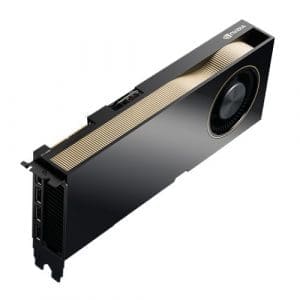
PNY RTXA6000 Professional Graphics Card, 48GB DDR6, 4 DP, Ampere Ray Tracing, 10752 Core, NVLink support, OEM (Brown Box)
£4,251.31 Add to basketQuick View -
£3,767.12
The Power to Create.
NVIDIA RTX technology revolutionized the way professionals work by delivering the power of real-time ray tracing, AI, and advanced graphics to millions of designers, artists, scientists, and researchers. Now, the NVIDIA Ampere architecture paves the way for a new era of innovative products, immersive entertainment, life-saving discoveries, and breath-taking designs-powered by the second generation of NVIDIA RTX.NVIDIA RTX A5500 unleashes new levels of performance, capability, and collaboration for professionals, inspiring them to create without boundaries by enabling artists, designers, engineers, and scientists to bring their imagination and insights to life. Designed for demanding workloads, the NVIDIA RTX A5500 provides professionals the ability to simultaneously run multiple applications with smooth interactions and no performance impacts. NVIDIA RTX A5500 delivers the stability, reliability, performance, and features required to build high-quality, immersive content and collaborate from anywhere. With 24 GB of GPU memory, expandable to 48GB with NVLink, the NVIDIA RTX A5500 easily handles large models, datasets, 3D renders, and complex scenes with higher fidelity and interactivity, helping users unlock new vistas of imagination and creativity from their desktops.Incredible Application PerformanceExperience fast, interactive performance-powered by the latest NVIDIA Ampere architecture-based GPU-with ultra-fast, on-board graphics memory technology and optimized software drivers for professional applications.The NVIDIA RTX A5500 includes 80 RT Cores to accelerate photorealistic ray-traced rendering up to 2x faster than the previous generation. Hardware accelerated Motion BVH (bounding volume hierarchy) improves motion blur rendering performance by up to 9x when compared to previous generation.With 320 Tensor Cores to accelerate AI workflows, the RTX A5500 provides the power necessary for AI development and training workloads. Incredible inferencing performance, combined with enterprise-class stability and reliability, make RTX A5500-powered desktop workstations ideal for professional AI training and inferencing deployments.Scale application performance even more with NVIDIA NVLink technology that lets you combine two RTX A5500 cards to double the effective GPU memory and performance in a single workstation chassis to 48 GB.Ensure hardware compatibility and stability through NVIDIA support of the latest OpenGL, DirectX, Vulkan, and CUDA standards, deep independent software vendor (ISV) developer engagements, and certification with over 100 professional software applications.NGC support gives engineers, researchers, and data scientists access to NVIDIA-tuned, tested, certified, and maintained containers for the top deep learning frameworks, as well as third-party managed high-performance computing (HPC) containers, NVIDIA HPC visualization containers, and partner applications.Rich, Expansive Visual WorkspaceExperience stunning imagery through movie-quality, anti-aliasing techniques, high-dynamic range (HDR) color support, higher refresh rates, and up to 8K screen resolution at 60 Hz from a single cable with DisplayPort 1.4a standard using Display Stream Compression (DSC).Enhance your desktop workspace experience with NVIDIA RTX Desktop Manager and NVIDIA Mosaic technology. Work across four displays on every NVIDIA RTX professional card with intuitive placement of windows, multiple virtual desktops, and user profiles.Use advanced multi-display technologies like Quadro Sync II, NVIDIA Mosaic, and Warp and Blend to synchronize images and scale resolution on a display surface with multiple projectors or screens.Value for IT AdministratorsExperience higher-quality products driven by power-efficient hardware and components selected for optimum operational performance, durability, and longevity.Enjoy maximum uptime thanks to exhaustive product testing with leading OEMs and system integrators that simulates the most demanding real-world conditions.Remotely monitor and manage NVIDIA professional products in your enterprise by integrating the NVIDIA Enterprise Management Toolkit (NVWMI) in your IT asset management framework.Scale up NVIDIA RTX Enterprise driver deployment to hundreds of workstations using NVWMI's powerful driver installer.Simplify software driver deployment through a regular cadence of long-life, stable driver releases based on a robust feature-development and quality-assurance process.NVIDIA NVLink- Scales memory and performance for the largest visual computing workloads
- Faster than PCIe-based solutions and offers flexible configurations
vGPU Software Support- NVIDIA Virtual PC (vPC)
- NVIDIA Virtual Applications (vApps)
- NVIDIA RTX Virtual Workstation (vWS)
- vGPU Profiles from 1 GB to 24 GB
Click here for more features
Out of stock

PNY RTXA5500 Professional Graphics Card, 24GB DDR6, 10240 Cores, 4 DP (1 x HDMI adapter), Ampere Architecture, Retail
£3,767.12 Read moreQuick View -
£3,695.83
The Power to Create.
NVIDIA RTX technology revolutionized the way professionals work by delivering the power of real-time ray tracing, AI, and advanced graphics to millions of designers, artists, scientists, and researchers. Now, the NVIDIA Ampere architecture paves the way for a new era of innovative products, immersive entertainment, life-saving discoveries, and breath-taking designs-powered by the second generation of NVIDIA RTX.NVIDIA RTX A5500 unleashes new levels of performance, capability, and collaboration for professionals, inspiring them to create without boundaries by enabling artists, designers, engineers, and scientists to bring their imagination and insights to life. Designed for demanding workloads, the NVIDIA RTX A5500 provides professionals the ability to simultaneously run multiple applications with smooth interactions and no performance impacts. NVIDIA RTX A5500 delivers the stability, reliability, performance, and features required to build high-quality, immersive content and collaborate from anywhere. With 24 GB of GPU memory, expandable to 48GB with NVLink, the NVIDIA RTX A5500 easily handles large models, datasets, 3D renders, and complex scenes with higher fidelity and interactivity, helping users unlock new vistas of imagination and creativity from their desktops.Incredible Application PerformanceExperience fast, interactive performance-powered by the latest NVIDIA Ampere architecture-based GPU-with ultra-fast, on-board graphics memory technology and optimized software drivers for professional applications.The NVIDIA RTX A5500 includes 80 RT Cores to accelerate photorealistic ray-traced rendering up to 2x faster than the previous generation. Hardware accelerated Motion BVH (bounding volume hierarchy) improves motion blur rendering performance by up to 9x when compared to previous generation.With 320 Tensor Cores to accelerate AI workflows, the RTX A5500 provides the power necessary for AI development and training workloads. Incredible inferencing performance, combined with enterprise-class stability and reliability, make RTX A5500-powered desktop workstations ideal for professional AI training and inferencing deployments.Scale application performance even more with NVIDIA NVLink technology that lets you combine two RTX A5500 cards to double the effective GPU memory and performance in a single workstation chassis to 48 GB.Ensure hardware compatibility and stability through NVIDIA support of the latest OpenGL, DirectX, Vulkan, and CUDA standards, deep independent software vendor (ISV) developer engagements, and certification with over 100 professional software applications.NGC support gives engineers, researchers, and data scientists access to NVIDIA-tuned, tested, certified, and maintained containers for the top deep learning frameworks, as well as third-party managed high-performance computing (HPC) containers, NVIDIA HPC visualization containers, and partner applications.Rich, Expansive Visual WorkspaceExperience stunning imagery through movie-quality, anti-aliasing techniques, high-dynamic range (HDR) color support, higher refresh rates, and up to 8K screen resolution at 60 Hz from a single cable with DisplayPort 1.4a standard using Display Stream Compression (DSC).Enhance your desktop workspace experience with NVIDIA RTX Desktop Manager and NVIDIA Mosaic technology. Work across four displays on every NVIDIA RTX professional card with intuitive placement of windows, multiple virtual desktops, and user profiles.Use advanced multi-display technologies like Quadro Sync II, NVIDIA Mosaic, and Warp and Blend to synchronize images and scale resolution on a display surface with multiple projectors or screens.Value for IT AdministratorsExperience higher-quality products driven by power-efficient hardware and components selected for optimum operational performance, durability, and longevity.Enjoy maximum uptime thanks to exhaustive product testing with leading OEMs and system integrators that simulates the most demanding real-world conditions.Remotely monitor and manage NVIDIA professional products in your enterprise by integrating the NVIDIA Enterprise Management Toolkit (NVWMI) in your IT asset management framework.Scale up NVIDIA RTX Enterprise driver deployment to hundreds of workstations using NVWMI's powerful driver installer.Simplify software driver deployment through a regular cadence of long-life, stable driver releases based on a robust feature-development and quality-assurance process.NVIDIA NVLink- Scales memory and performance for the largest visual computing workloads
- Faster than PCIe-based solutions and offers flexible configurations
vGPU Software Support- NVIDIA Virtual PC (vPC)
- NVIDIA Virtual Applications (vApps)
- NVIDIA RTX Virtual Workstation (vWS)
- vGPU Profiles from 1 GB to 24 GB
Click here for more features
Out of stock

PNY RTXA5500 Professional Graphics Card, 24GB DDR6, 10240 Cores, 4 DP, Ampere Architecture, OEM (Brown Box)
£3,695.83 Read moreQuick View -
£2,690.78
Performance for Endless Possibilities
Industries are embracing accelerated computing and AI to tackle powerful dynamics and unlock transformative possibilities. Generative AI is reshaping the way professionals create and innovate across various domains, from design and engineering to entertainment and healthcare.The NVIDIA RTX 4500 Ada Generation, built on the ultra-efficient NVIDIA Ada Lovelace architecture, combines 60 third-generation RT Cores, 240 fourth-generation Tensor Cores, and 7,680 CUDA® cores with 24GB of graphics memory to deliver fast ray tracing and AI-powered graphics. Discover new ways to create an incredible workflow acceleration with RTX 4500.NVIDIA Ada Lovelace ArchitectureExperience fast, interactive performance—powered by the latest NVIDIA Ada Lovelace architecture-based GPU—with ultra-fast, onboard graphics memory technology and optimized software drivers for professional applications. The Shader Execution Reordering (SER) system allows on-the-fly organization and reordering of workloads, grouping similar performing threads so the streaming multiprocessor (SM) and RT Core can operate more efficiently.CUDA CoresThe NVIDIA Ada Lovelace architecture-based CUDA® cores provide up to 2X the single-precision floating-point (FP32) throughput compared to the previous generation, providing significant performance improvements for graphics workflows such as 3D modeling and compute for workloads such as CAE.Third-Generation RT CoresThird-generation RT Cores provide up to 2X the throughput of the previous generation and the ability to run ray tracing with either shading or denoising capabilities concurrently. This accelerates renders for M&E content creation, AECO design evaluations, and manufacturing virtual prototyping. Third-generation RT Cores deliver up to 2X the ray-tracing performance over the previous generation, delivering groundbreaking performance for photorealistic rendering. Enhanced RT Cores combined with new SER technology dynamically reorder inefficient workloads, dramatically improving shader performance to accelerate end-to-end ray-traced image rendering performance.Fourth-Generation Tensor CoresFourth-generation Tensor Cores provide up to 4X faster AI training performance than the previous generation with FP16 precision. Support for the new FP8 data format for inference provides more than 4X faster performance than the previous generation and reduces data memory usage by half (compared to the FP16 data format).Encode and Decode EnginesRTX 4500 includes two video encode engines and two decode engines, including support for the AV1 video format and the performance required for multi-stream video applications for security and video serving.PCIe Gen 4RTX 4500 supports PCIe Gen4, which doubles the bandwidth of PCIe Gen3 from 15.75GB/s to 31.5GB/s for x16 connections, improving data transfer speeds from CPU memory for data-intensive tasks such as AI, data science, and creating large 3D models and scenes. Faster PCIe performance also accelerates GPU DMA transfers, providing faster video data transfers from GPUDirect for Video-enabled devices and faster IO with GPUDirect Storage.GPU MemoryRTX 4500 features 24GB of GDDR6 memory, providing the memory needed for rendering, data science, engineering simulation, and other GPU memory-intensive applications. With greater memory bandwidth than the previous generation, RTX 4500 can move data between the GPU and GPU memory faster, resulting in better graphics, compute, and rendering performance.Multi-DisplayFour mini-DisplayPort 1.4a connectors, support for multiple 8K monitors, NVIDIA Quadro Sync, Mosaic, and Warp and Blend enable massive immersive environments for CAVE, video walls, and location-based entertainment deployments.Extended RealitySupport for the latest high-resolution HMD devices, high-performance graphics, and 20GB of GPU memory enable the creation of AR and VR experiences for training, product validations, building walkthroughs, and compelling entertainment.Form Factor and Power EfficiencyWith a single-slot, low-profile form factor, and power-efficient design, RTX 4000 fits into a wide range of workstation chassis, providing professionals with a generous selection of compatible workstations from worldwide OEM vendors and delivering a groundbreaking GPU architecture for AI and AI-based neural graphics in desktop workstations.Motion BVHHardware-accelerated rendering of motion blur—a common cinematic effect that's difficult to render—means artists no longer need to rely on traditional methods of using motion vectors to achieve motion blur. Motion vectors allow the artist to adjust motion blur in post but require visual fixes for reflections and translucency.NVIDIA DLSS 3.0The Ada Lovelace GPU architecture features a new Optical Flow Accelerator and AI-based DLSS Super Resolution with DL denoiser that boost DLSS 3.0's frame rates up to 4X compared to the previous version while maintaining or exceeding native image quality.NVIDIA RTX Broadcast EngineThe NVIDIA RTX Broadcast Engine transforms offices into broadcast studios, upgrading standard webcams and microphones into premium smart devices with the power of AI. Improve the video and audio quality of live streams with AI capabilities such as virtual backgrounds, webcam auto frame, and microphone noise removal. With dedicated AI processors called Tensor Cores on NVIDIA RTX GPUs, the AI networks can run in real-time alongside your applications.NVIDIA RTX ExperienceNVIDIA RTX Experience delivers a suite of productivity tools to your desktop workstation, including desktop recording in up to 8K, automatic alerts for the latest NVIDIA RTX Enterprise driver updates, and access gaming features.NVIDIA CUDA Parallel Computing Platform
Natively execute standard programming languages like C/C++ and Fortran, and APIs such as OpenCL, OpenACC, and Direct Compute to accelerate techniques such as ray tracing, video and image processing, and computation fluid dynamics.Unified MemoryA single, seamless 49-bit virtual address space allows for the transparent migration of data between the full allocation of CPU and GPU memory.NVIDIA GPU Direct for VideoGPUDirect for Video speeds communication between the GPU and video I/O devices by avoiding unnecessary system memory copies and CPU overhead.NVIDIA Enterprise Management ToolsMaximize system uptime, seamlessly manage wide-scale deployments, and remotely control graphics and display settings for efficient operations.Out of stock
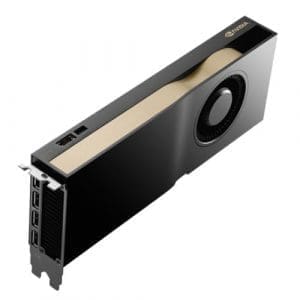
PNY RTX4500 Ada Lovelace Professional Graphics Card, 24GB DDR6, 4 DP (HDMI adapter), 7680 CUDA Cores, Dual-Slot, Retail
£2,690.78 Read moreQuick View -
£2,535.54
Performance for Endless Possibilities
Industries are embracing accelerated computing and AI to tackle powerful dynamics and unlock transformative possibilities. Generative AI is reshaping the way professionals create and innovate across various domains, from design and engineering to entertainment and healthcare.The NVIDIA RTX 4500 Ada Generation, built on the ultra-efficient NVIDIA Ada Lovelace architecture, combines 60 third-generation RT Cores, 240 fourth-generation Tensor Cores, and 7,680 CUDA® cores with 24GB of graphics memory to deliver fast ray tracing and AI-powered graphics. Discover new ways to create an incredible workflow acceleration with RTX 4500.NVIDIA Ada Lovelace ArchitectureExperience fast, interactive performance—powered by the latest NVIDIA Ada Lovelace architecture-based GPU—with ultra-fast, onboard graphics memory technology and optimized software drivers for professional applications. The Shader Execution Reordering (SER) system allows on-the-fly organization and reordering of workloads, grouping similar performing threads so the streaming multiprocessor (SM) and RT Core can operate more efficiently.CUDA CoresThe NVIDIA Ada Lovelace architecture-based CUDA® cores provide up to 2X the single-precision floating-point (FP32) throughput compared to the previous generation, providing significant performance improvements for graphics workflows such as 3D modeling and compute for workloads such as CAE.Third-Generation RT CoresThird-generation RT Cores provide up to 2X the throughput of the previous generation and the ability to run ray tracing with either shading or denoising capabilities concurrently. This accelerates renders for M&E content creation, AECO design evaluations, and manufacturing virtual prototyping. Third-generation RT Cores deliver up to 2X the ray-tracing performance over the previous generation, delivering groundbreaking performance for photorealistic rendering. Enhanced RT Cores combined with new SER technology dynamically reorder inefficient workloads, dramatically improving shader performance to accelerate end-to-end ray-traced image rendering performance.Fourth-Generation Tensor CoresFourth-generation Tensor Cores provide up to 4X faster AI training performance than the previous generation with FP16 precision. Support for the new FP8 data format for inference provides more than 4X faster performance than the previous generation and reduces data memory usage by half (compared to the FP16 data format).Encode and Decode EnginesRTX 4500 includes two video encode engines and two decode engines, including support for the AV1 video format and the performance required for multi-stream video applications for security and video serving.PCIe Gen 4RTX 4500 supports PCIe Gen4, which doubles the bandwidth of PCIe Gen3 from 15.75GB/s to 31.5GB/s for x16 connections, improving data transfer speeds from CPU memory for data-intensive tasks such as AI, data science, and creating large 3D models and scenes. Faster PCIe performance also accelerates GPU DMA transfers, providing faster video data transfers from GPUDirect for Video-enabled devices and faster IO with GPUDirect Storage.GPU MemoryRTX 4500 features 24GB of GDDR6 memory, providing the memory needed for rendering, data science, engineering simulation, and other GPU memory-intensive applications. With greater memory bandwidth than the previous generation, RTX 4500 can move data between the GPU and GPU memory faster, resulting in better graphics, compute, and rendering performance.Multi-DisplayFour mini-DisplayPort 1.4a connectors, support for multiple 8K monitors, NVIDIA Quadro Sync, Mosaic, and Warp and Blend enable massive immersive environments for CAVE, video walls, and location-based entertainment deployments.Extended RealitySupport for the latest high-resolution HMD devices, high-performance graphics, and 20GB of GPU memory enable the creation of AR and VR experiences for training, product validations, building walkthroughs, and compelling entertainment.Form Factor and Power EfficiencyWith a single-slot, low-profile form factor, and power-efficient design, RTX 4000 fits into a wide range of workstation chassis, providing professionals with a generous selection of compatible workstations from worldwide OEM vendors and delivering a groundbreaking GPU architecture for AI and AI-based neural graphics in desktop workstations.Motion BVHHardware-accelerated rendering of motion blur—a common cinematic effect that's difficult to render—means artists no longer need to rely on traditional methods of using motion vectors to achieve motion blur. Motion vectors allow the artist to adjust motion blur in post but require visual fixes for reflections and translucency.NVIDIA DLSS 3.0The Ada Lovelace GPU architecture features a new Optical Flow Accelerator and AI-based DLSS Super Resolution with DL denoiser that boost DLSS 3.0's frame rates up to 4X compared to the previous version while maintaining or exceeding native image quality.NVIDIA RTX Broadcast EngineThe NVIDIA RTX Broadcast Engine transforms offices into broadcast studios, upgrading standard webcams and microphones into premium smart devices with the power of AI. Improve the video and audio quality of live streams with AI capabilities such as virtual backgrounds, webcam auto frame, and microphone noise removal. With dedicated AI processors called Tensor Cores on NVIDIA RTX GPUs, the AI networks can run in real-time alongside your applications.NVIDIA RTX ExperienceNVIDIA RTX Experience delivers a suite of productivity tools to your desktop workstation, including desktop recording in up to 8K, automatic alerts for the latest NVIDIA RTX Enterprise driver updates, and access gaming features.NVIDIA CUDA Parallel Computing Platform
Natively execute standard programming languages like C/C++ and Fortran, and APIs such as OpenCL, OpenACC, and Direct Compute to accelerate techniques such as ray tracing, video and image processing, and computation fluid dynamics.Unified MemoryA single, seamless 49-bit virtual address space allows for the transparent migration of data between the full allocation of CPU and GPU memory.NVIDIA GPU Direct for VideoGPUDirect for Video speeds communication between the GPU and video I/O devices by avoiding unnecessary system memory copies and CPU overhead.NVIDIA Enterprise Management ToolsMaximize system uptime, seamlessly manage wide-scale deployments, and remotely control graphics and display settings for efficient operations.Out of stock
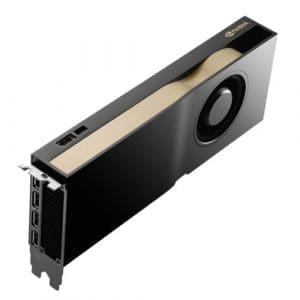
PNY RTX4500 Ada Lovelace Professional Graphics Card, 24GB DDR6, 4 DP, 7680 CUDA Cores, Dual-Slot, OEM (Brown Box)
£2,535.54 Read moreQuick View -
£2,165.84
Perfectly Balanced. Blazing Performance
Two years ago, the NVIDIA® Quadro RTX™ platform revolutionized professional visual computing forever. Based on the NVIDIA Turing™ GPU architecture and armed with real-time ray tracing, accelerated AI, and photorealistic VR, it enabled designers and engineers to do their life’s work at a level of quality and performance unlike ever before. But the pace of innovation and the drive to achieve new breakthroughs do not cease. And now, global circumstances have presented a new set of challenges for professionals to create, build, entertain and discover in a world that looks dramatically different than the recent past.The NVIDIA RTX A5000 delivers the power, performance, capabilities, and reliability professionals need to bring their boldest ideas to life. And with 24 GB of GPU memory, you’ll experience faster performance with your favorite applications. So you can tackle larger models, renders, datasets, and scenes with higher-fidelity and interactivity, releasing untapped potential for endless creativity from your desktop.Incredible Application Performance- Experience fast, interactive performance—powered by the latest NVIDIA Ampere architecture GPU—with ultra-fast, on-board graphics memory technology and optimized software drivers for professional applications.
- The NVIDIA RTX A5000 includes 64 RT Cores to accelerate photorealistic ray-traced rendering up to 2x faster than the previous generation. Hardware accelerated Motion BVH (bounding volume hierarchy) improves motion blur rendering performance by up to 7X when compared to previous generation.
- With 256 Tensor Cores to accelerate AI workflows, the RTX A5000 provides the power necessary for AI development and training workloads. Incredible inferencing performance, combined with Quadro enterprise-class stability and reliability, make RTX A5000-powered desktop workstations ideal for professional AI training and inferencing deployments.
- Scale application performance even more with NVIDIA NVLink technology that lets you combine two RTX A5000 cards to double the effective GPU memory and performance in a single workstation chassis to 48 GB.
- NGC™ support gives engineers, researchers, and data scientists access to NVIDIA-tuned, tested, certified, and maintained containers for the top deep learning frameworks, as well as third-party managed high-performance computing (HPC) containers, NVIDIA HPC visualization containers, and partner applications.
Rich, Expansive Visual Workspace- Experience stunning imagery through movie-quality, anti-aliasing techniques, high-dynamic range (HDR) color support, higher refresh rates, and up to 8K screen resolution at 60 Hz from a single cable with the DisplayPort 1.4a standard.
- Enhance your desktop workspace experience with NVIDIA Quadro View desktop management software and NVIDIA Mosaic technology. Work across four displays on every Quadro card with intuitive placement of windows, multiple virtual desktops, and user profiles.
- Use advanced multi-display technologies like Quadro Sync II, Quadro Mosaic, and Quadro Warp and Blend to synchronize images and scale resolution on a display surface with multiple projectors or screens.
Proven Reliability- Experience higher-quality products driven by power-efficient hardware and components selected for optimum operational performance, durability, and longevity.
- Enjoy maximum uptime thanks to exhaustive product testing with leading OEMs and system integrators that simulates the most demanding real-world conditions.
Easy Manageability- Remotely monitor and manage Quadro products in your enterprise by integrating the NVIDIA Enterprise Management Toolkit (NVWMI) in your IT asset management framework.
- Scale up Quadro driver deployment to hundreds of workstations using NVWMI’s powerful driver installer.
- Simplify software driver deployment through a regular cadence of long-life, stable driver releases based on a robust feature-development and quality-assurance process.
Out of stock

PNY RTXA5000 Professional Graphics Card, 24GB DDR6, 4 DP (HDMI adapter), Ampere Ray Tracing, 8192 Core, NVLink support, Retail
£2,165.84 Read moreQuick View -
£2,077.24
Perfectly Balanced. Blazing Performance
Two years ago, the NVIDIA® Quadro RTX™ platform revolutionized professional visual computing forever. Based on the NVIDIA Turing™ GPU architecture and armed with real-time ray tracing, accelerated AI, and photorealistic VR, it enabled designers and engineers to do their life’s work at a level of quality and performance unlike ever before. But the pace of innovation and the drive to achieve new breakthroughs do not cease. And now, global circumstances have presented a new set of challenges for professionals to create, build, entertain and discover in a world that looks dramatically different than the recent past.The NVIDIA RTX A5000 delivers the power, performance, capabilities, and reliability professionals need to bring their boldest ideas to life. And with 24 GB of GPU memory, you’ll experience faster performance with your favorite applications. So you can tackle larger models, renders, datasets, and scenes with higher-fidelity and interactivity, releasing untapped potential for endless creativity from your desktop.Incredible Application Performance- Experience fast, interactive performance—powered by the latest NVIDIA Ampere architecture GPU—with ultra-fast, on-board graphics memory technology and optimized software drivers for professional applications.
- The NVIDIA RTX A5000 includes 64 RT Cores to accelerate photorealistic ray-traced rendering up to 2x faster than the previous generation. Hardware accelerated Motion BVH (bounding volume hierarchy) improves motion blur rendering performance by up to 7X when compared to previous generation.
- With 256 Tensor Cores to accelerate AI workflows, the RTX A5000 provides the power necessary for AI development and training workloads. Incredible inferencing performance, combined with Quadro enterprise-class stability and reliability, make RTX A5000-powered desktop workstations ideal for professional AI training and inferencing deployments.
- Scale application performance even more with NVIDIA NVLink technology that lets you combine two RTX A5000 cards to double the effective GPU memory and performance in a single workstation chassis to 48 GB.
- NGC™ support gives engineers, researchers, and data scientists access to NVIDIA-tuned, tested, certified, and maintained containers for the top deep learning frameworks, as well as third-party managed high-performance computing (HPC) containers, NVIDIA HPC visualization containers, and partner applications.
Rich, Expansive Visual Workspace- Experience stunning imagery through movie-quality, anti-aliasing techniques, high-dynamic range (HDR) color support, higher refresh rates, and up to 8K screen resolution at 60 Hz from a single cable with the DisplayPort 1.4a standard.
- Enhance your desktop workspace experience with NVIDIA Quadro View desktop management software and NVIDIA Mosaic technology. Work across four displays on every Quadro card with intuitive placement of windows, multiple virtual desktops, and user profiles.
- Use advanced multi-display technologies like Quadro Sync II, Quadro Mosaic, and Quadro Warp and Blend to synchronize images and scale resolution on a display surface with multiple projectors or screens.
Proven Reliability- Experience higher-quality products driven by power-efficient hardware and components selected for optimum operational performance, durability, and longevity.
- Enjoy maximum uptime thanks to exhaustive product testing with leading OEMs and system integrators that simulates the most demanding real-world conditions.
Easy Manageability- Remotely monitor and manage Quadro products in your enterprise by integrating the NVIDIA Enterprise Management Toolkit (NVWMI) in your IT asset management framework.
- Scale up Quadro driver deployment to hundreds of workstations using NVWMI’s powerful driver installer.
- Simplify software driver deployment through a regular cadence of long-life, stable driver releases based on a robust feature-development and quality-assurance process.
9 in stock
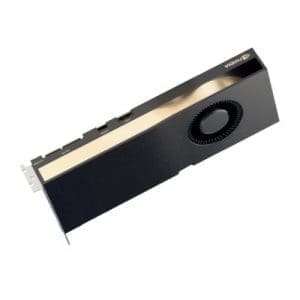
PNY RTXA5000 Professional Graphics Card, 24GB DDR6, 4 DP, Ampere Ray Tracing, 8192 Core, NVLink support, OEM (Brown Box)
£2,077.24 Add to basketQuick View -
£1,470.90
Performance for Endless Possibilities
The NVIDIA RTX 4000 Ada Generation is the most powerful single-slot GPU for professionals, providing massive breakthroughs in speed and power efficiency over the previous generation to tackle demanding creative, design, and engineering workflows from the desktop. Harnessing the latest-generation RT Cores, Tensor Cores, and CUDA® cores alongside 20GB of graphics memory, RTX 4000 empowers professionals to create intricate product engineering, visionary cityscapes, and immersive entertainment experiences. With its power-efficient, single-slot design, RTX 4000 seamlessly fits into various workstation chassis, offering limitless potential for professionals.NVIDIA Ada Lovelace ArchitectureExperience fast, interactive performance—powered by the latest NVIDIA Ada Lovelace architecture-based GPU—with ultra-fast, onboard graphics memory technology and optimized software drivers for professional applications. The Shader Execution Reordering (SER) system allows on-the-fly organization and reordering of workloads, grouping similar performing threads so the streaming multiprocessor (SM) and RT Core can operate more efficiently.CUDA CoresThe NVIDIA Ada Lovelace architecture-based CUDA cores deliver up to 2X the single-precision floating-point (FP32) throughput compared to the previous generation, providing significant performance improvements for graphics workflows such as 3D model development and compute for workloads like desktop simulation for CAE.Third-Generation RT CoresThird-generation RT Cores provide up to 2X the throughput of the previous generation and the ability to run ray tracing with either shading or denoising capabilities concurrently. This accelerates renders for M&E content creation, AECO design evaluations, and manufacturing virtual prototyping. Third-generation RT Cores deliver up to 2X the ray-tracing performance over the previous generation, delivering groundbreaking performance for photorealistic rendering. Enhanced RT Cores combined with new SER technology dynamically reorder inefficient workloads, dramatically improving shader performance to accelerate end-to-end ray-traced image rendering performance.Fourth Generation Tensor CoresFourth-generation Tensor Cores provide up to 4X faster AI training performance than the previous generation with FP16 precision. Support for the new FP8 data format for inference provides more than 4X faster performance than the previous generation and reduces data memory usage by half (compared to the FP16 data format).PCIe Gen 4RTX 4000 supports PCIe Gen4, which doubles the bandwidth of PCIe Gen3 from 15.75GB/sec to 31.5 GB/sec for x16 connections, improving data transfer speeds from CPU memory for data-intensive tasks such as AI, data science, and creating 3D models from large datasets. Faster PCIe performance also accelerates GPU DMA transfers, providing faster video data transfers from GPUDirect for Video-enabled devices and faster IO with GPUDirect Storage.Higher Speed GDDR6 MemoryRTX 4000 features 20GB of GDDR6 memory, providing the memory needed for rendering, data science, engineering simulation, and other GPU memory-intensive applications. Support for ECC memory delivers uncompromised computing accuracy and reliability for mission-critical applications.Multi-DisplayFour mini-DisplayPort 1.4a connectors, support for multiple 8K monitors, NVIDIA Quadro Sync, Mosaic, and Warp and Blend enable massive immersive environments for CAVE, video walls, and location-based entertainment deployments.Extended RealitySupport for the latest high-resolution HMD devices, high-performance graphics, and 20GB of GPU memory enable the creation of AR and VR experiences for training, product validations, building walkthroughs, and compelling entertainment.Form Factor and Power EfficiencyWith a single-slot, low-profile form factor, and power-efficient design, RTX 4000 fits into a wide range of workstation chassis, providing professionals with a generous selection of compatible workstations from worldwide OEM vendors and delivering a groundbreaking GPU architecture for AI and AI-based neural graphics in desktop workstations.Motion BVHHardware-accelerated rendering of motion blur—a common cinematic effect that's difficult to render—means artists no longer need to rely on traditional methods of using motion vectors to achieve motion blur. Motion vectors allow the artist to adjust motion blur in post but require visual fixes for reflections and translucency.NVIDIA DLSSThe Ada Lovelace GPU architecture features a new Optical Flow Accelerator and AI-based DLSS Super Resolution with DL denoiser that boost DLSS 3.0's frame rates up to 4X compared to the previous version while maintaining or exceeding native image quality.NVIDIA RTX Broadcast EngineThe NVIDIA RTX Broadcast Engine transforms offices into broadcast studios, upgrading standard webcams and microphones into premium smart devices with the power of AI. Improve the video and audio quality of live streams with AI capabilities such as virtual backgrounds, webcam auto frame, and microphone noise removal. With dedicated AI processors called Tensor Cores on NVIDIA RTX GPUs, the AI networks can run in real-time alongside your applications.NVIDIA RTX ExperienceNVIDIA RTX Experience delivers a suite of productivity tools to your desktop workstation, including desktop recording in up to 8K, automatic alerts for the latest NVIDIA RTX Enterprise driver updates, and access gaming features. The application is available for download here.NVIDIA CUDA Parallel Computing PlatformNatively execute standard programming languages like C/C++ and Fortran, and APIs such as OpenCL, OpenACC, and Direct Compute to accelerate techniques such as ray tracing, video and image processing, and computation fluid dynamics.Unified MemoryA single, seamless 49-bit virtual address space allows for the transparent migration of data between the full allocation of CPU and GPU memory.NVIDIA GPU Direct for VideoGPUDirect for Video speeds communication between the GPU and video I/O devices by avoiding unnecessary system memory copies and CPU overhead.NVIDIA Enterprise Management ToolsMaximize system uptime, seamlessly manage wide-scale deployments, and remotely control graphics and display settings for efficient operations.Out of stock
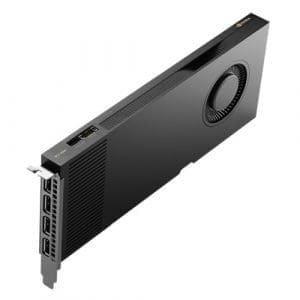
PNY RTX4000 Ada Lovelace Professional Graphics Card, 20GB DDR6, 4 DP (HDMI adapter), 6144 CUDA Cores, Single-Slot, Retail
£1,470.90 Read moreQuick View -
£1,449.18
Powerful Performance for Professionals
- CUDA Cores: 7168
- Tensor Cores: 224
- RT Cores: 56
- Single Precision Performance: 23.7 TFLOPS
- RT Core Performance: 46.2 TFLOPS
- Tensor Performance: 189.2 TFLOPS
- GPU Memory: 20GB GDDR6 with ECC
- Memory Interface: 320-bit
- Memory Bandwidth: 640 GB/sec
- System Interface: PCI Express 4.0 x16
- Display Connectors: 4x DisplayPort 1.4a
- Maximum Power Consumption: 200 W
The NVIDIA RTX A4500 delivers the power, performance, capabilities, and reliability professionals need to do more. Powered by latest generation of NVIDIA RTX technology, combined with 20GB of ultra-fast GPU memory, the A4500 provides amazing performance with your favorite applications and the capability to work with larger models, renders, datasets, and scenes with higher fidelity and greater interactivity, taking your work to the next level.With the introduction of the NVIDIA Ampere architecture, the next generation of NVIDIA RTX became available to millions of professionals. Featuring enhanced real-time ray tracing, accelerated AI, and advanced graphics and compute capabilities, the NVIDIA Ampere architecture enables artists, designers, engineers, and scientists to create tomorrow, today. And as the adoption of RTX technology continues to grow, with over 70 of the world's leading professional applications now accelerated by RTX technology, professionals are empowered to design, build, and entertain unlike ever before.Incredible Application PerformanceExperience fast, interactive performance—powered by the latest NVIDIA Ampere architecture-based GPU—with ultra-fast graphics memory technology and optimized software drivers for professional applications.The NVIDIA RTX A4500 includes 56 RT Cores to accelerate photorealistic ray-traced rendering up to 2x faster than the previous generation. Hardware-accelerated Motion BVH (bounding volume hierarchy) improves motion blur rendering performance by up to 10X compared to the previous generation.With 224 Tensor Cores to accelerate AI workflows, the RTX A4500 provides the compute power necessary for AI development and training workloads, as well as inferencing deployments.Ensure hardware compatibility and stability through NVIDIA support of the latest OpenGL, DirectX, Vulkan, and CUDA standards, and deep engagements with independent software vendor (ISV) developer engagements, providing certification for over 100 professional software applications.Rich, Expansive Visual WorkspaceExperience stunning imagery through movie-quality, anti-aliasing techniques, high-dynamic-range (HDR) color support, higher refresh rates, and up to 8K screen resolution at 60 Hz from a single cable with the DisplayPort 1.4a standard using Display Stream Compression (DSC).Enhance your desktop workspace experience with NVIDIA RTX Desktop Manager, formerly NVIDIA Quadro View, and NVIDIA Mosaic technology. Work across four displays on every NVIDIA RTX professional card with intuitive placement of windows and user profiles.Use advanced multi-display technologies like Quadro Sync II, NVIDIA Mosaic, and Warp and Blend to synchronize images and scale resolution on a display surface composed of multiple projectors or screens.Value for IT AdministratorsExperience higher-quality products driven by power-efficient hardware and components selected for optimum operational performance, durability, and longevity.Enjoy maximum uptime thanks to exhaustive product testing with leading OEMs and system integrators that simulates the most demanding real-world conditions.Remotely monitor and manage NVIDIA professional products in your enterprise by integrating the NVIDIA Enterprise Management Toolkit (NVWMI) in your IT asset management framework.Scale-up with the NVIDIA RTX Enterprise driver, simplifying deployment to hundreds of workstations using NVWMI's powerful driver installer.Simplify software driver deployment through a regular cadence of long-life, stable driver releases based on a robust feature-development and quality-assurance process.Performance and Useability FeaturesNVIDIA Ampere ArchitectureNVIDIA RTX A4500 workstation GPU offers high performance real-time ray tracing, AI-accelerated compute, and professional graphics rendering within an optimized power envelope. Building upon the major SM enhancements from the Turing GPU, the NVIDIA Ampere architecture enhances ray tracing operations, tensor matrix operations, and concurrent executions of FP32 and INT32 operations.CUDA CoresThe NVIDIA Ampere architecture-based CUDA cores bring up to 2x the single-precision floating point (FP32) throughput compared to the previous generation CUDA Cores, providing significant performance improvements for graphics workflows such as 3D model development and compute for workloads such as desktop simulation for computer-aided engineering (CAE). The RTX A4500 enables two FP32 primary data paths, doubling the peak FP32 operations.Second Generation RT CoresIncorporating second-generation ray tracing engines, NVIDIA Ampere architecture-based GPUs provide incredible ray traced rendering performance. A single RTX A4500 board can render complex professional models with physically accurate shadows, reflections, and refractions to empower users with instant insight. Working in concert with applications leveraging APIs such as NVIDIA OptiX, Microsoft DXR and Vulkan ray tracing, systems based on the RTX A4500 will power truly interactive design workflows to provide immediate feedback for unprecedented levels of productivity. This latest generation of RT Cores is up to 2x faster in ray tracing compared to the previous generation. This technology also speeds up the rendering of ray-traced motion blur for faster results with greater visual accuracy.Third Generation Tensor CoresPurpose-built for deep learning matrix arithmetic at the heart of neural network training and inferencing functions, the RTX A4500 includes enhanced Tensor Cores that accelerate more datatypes, and includes a new Fine-Grained Structured Sparsity feature that delivers up to 2x throughput for tensor matrix operations compared to the previous generation Tensor Cores. New Tensor Cores will accelerate two new TF32 and BFloat16 precision modes. Independent floating-point and integer data paths allow more efficient execution of workloads using a mix of computation and addressing calculations.PCIe Gen 4The RTX A4500 supports PCI Express Gen 4, which provides double the bandwidth of PCIe Gen 3, improving data-transfer speeds from CPU memory for data-intensive tasks like AI and data science.Higher Speed GDDR6 MemoryBuilt with 20GB GDDR6 memory, the RTX A4500 delivers the memory throughput required for memory intensive tasks such as ray tracing, rendering, and AI workloads. The RTX A4500 provides large graphics memory to address the larger datasets and models in latency-sensitive professional applications.Error Correcting Code (ECC) on Graphics MemoryMeet strict data integrity requirements for mission critical applications with uncompromised computing accuracy and reliability for workstations.Fifth Generation NVDEC EngineNVDEC is well suited for transcoding and video playback applications for real-time decoding. The following video codecs are supported for hardware-accelerated decoding: MPEG-2, VC-1, H.264 (AVCHD), H.265 (HEVC), VP8, VP9, and AV1.Seventh Generation NVENC EngineNVENC can take on the most demanding 4K or 8K video encoding tasks to free up the graphics engine and the CPU for other operations. The RTX 4500 provides better encoding quality than software-based x264 encoders.Graphics PreemptionPixel-level preemption provides more granular control to better support time-sensitive tasks such as VR motion tracking.Compute PreemptionPreemption at the instruction-level provides finer grain control over compute tasks to prevent long-running applications from either monopolizing system resources or timing out.NVIDIA RTX IOAccelerating GPU-based lossless decompression performance by up to 100x and 20x lower CPU utilization compared to traditional storage APIs using Microsoft’s new DirectStorage for Windows API. RTX IO moves data from the storage to the GPU in a more efficient, compressed form, and improving I/O performance.Multi-GPU Technology SupportThird Generation NVLinkConnect two RTX A4500 cards with NVLink to double the effective memory footprint and scale application performance by enabling GPU-to-GPU data transfers at rates up to 112.5 GB/s (total bandwidth).NVIDIA SLI TechnologyLeverage multiple GPUs to dynamically scale graphics performance, enhance image quality, expand display real estate, and assemble a fully virtualized systemDisplay FeaturesNVIDIA Quadro Mosaic™ TechnologyTransparently scale the desktop and applications across up to 4 GPUs and 16 displays from a single workstation while delivering full performance and image quality.DisplayPort 1.4aSupport up to four 5K monitors at 60Hz, or dual 8K displays at 60Hz per card. The RTX A400 supports HDR color for 4K at 60Hz for 10/12b HEVC decode and up to 4K at 60Hz for 10b HEVC encode. Each DisplayPort connector can drive ultra-high resolutions of 4096 x 2160 at 120 Hz with 30-bit color.NVIDIA RTX Desktop ManagerGain unprecedented end-user control of the desktop experience for increased productivity in single large display or multi-display environments, especially in the current age of large, widescreen displays.NVIDIA Quadro Sync IISynchronize the display and image output of up to 32 displays[iii] from 8 GPUs (connected through two Sync II boards) in a single system, reducing the number of machines needed to create an advanced video visualization environment.Frame Lock Connector LatchEach frame lock connector is designed with a self-locking retention mechanism to secure its connection with the frame lock cable to provide robust connectivity and maximum productivity.OpenGL Quad Buffered Stereo SupportProvide a smooth and immersive 3D Stereo experience for professional applications.Ultra-High-Resolution Desktop SupportGet more Mosaic topology choices with high resolution displays devices with a 32K Max desktop size.Professional 3D Stereo SynchronizationRobust control of stereo effects through a dedicated connection to directly synchronize 3D stereo hardware to an NVIDIA RTX professional graphics card.Software SupportNVIDIA Virtual GPU SoftwareSupport for NVIDIA virtual GPU (vGPU) software allows a personal workstation to be repurposed into multiple high-performance virtual workstation instances enabling remote users, to share resources to drive high-end design, AI, and compute workloads.NVIDIA RTX ExperienceNVIDIA RTX Experience delivers a suite of productivity tools to your desktop workstation, including desktop recording in up to 8K, automatic alerts for the latest NVIDIA RTX Enterprise driver updates, and access gaming features. The application is available for download.Software Optimized for AIDeep learning frameworks such as Caffe2, MXNet, CNTK, TensorFlow, and others deliver dramatically faster training times and higher multi-node training performance. GPU accelerated libraries such as cuDNN, cuBLAS, and TensorRT delivers higher performance for both deep learning inference and High- Performance Computing (HPC) applications.NVIDIA CUDA Parallel Computing PlatformNatively execute standard programming languages like C/C++ and Fortran, and APIs such as OpenCL, OpenACC and Direct Compute to accelerates techniques such as ray tracing, video and image processing, and computation fluid dynamics.Unified MemoryA single, seamless 49-bit virtual address space allows for the transparent migration of data between the full allocation of CPU and GPU memory.NVIDIA GPUDirect for VideoGPUDirect for Video speeds communication between the GPU and video I/O devices by avoiding unnecessary system memory copies and CPU overhead.NVIDIA Enterprise-Management ToolsMaximize system uptime, seamlessly manage wide-scale deployments, and remotely control graphics and display settings for efficient operations.Out of stock
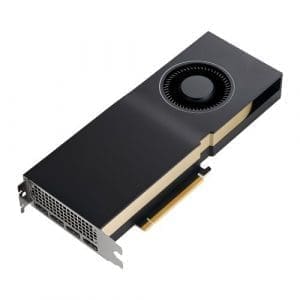
PNY RTXA4500 Professional Graphics Card, 20GB DDR6, 4 DP, Ampere Ray Tracing, 7168 Cores, NVLink Support, OEM (Brown Box)
£1,449.18 Read moreQuick View -
£1,423.38
Powerful Performance for Professionals
The NVIDIA RTX A4500 delivers the power, performance, capabilities, and reliability professionals need to do more. Powered by latest generation of NVIDIA RTX technology, combined with 20GB of ultra-fast GPU memory, the A4500 provides amazing performance with your favorite applications and the capability to work with larger models, renders, datasets, and scenes with higher fidelity and greater interactivity, taking your work to the next level.With the introduction of the NVIDIA Ampere architecture, the next generation of NVIDIA RTX became available to millions of professionals. Featuring enhanced real-time ray tracing, accelerated AI, and advanced graphics and compute capabilities, the NVIDIA Ampere architecture enables artists, designers, engineers, and scientists to create tomorrow, today. And as the adoption of RTX technology continues to grow, with over 70 of the world's leading professional applications now accelerated by RTX technology, professionals are empowered to design, build, and entertain unlike ever before.- CUDA Cores: 7168
- Tensor Cores: 224
- RT Cores: 56
- Single Precision Performance: 23.7 TFLOPS
- RT Core Performance: 46.2 TFLOPS
- Tensor Performance: 189.2 TFLOPS
- GPU Memory: 20GB GDDR6 with ECC
- Memory Interface: 320-bit
- Memory Bandwidth: 640 GB/sec
- System Interface: PCI Express 4.0 x16
- Display Connectors: 4x DisplayPort 1.4a
- Maximum Power Consumption: 200 W
Incredible Application PerformanceExperience fast, interactive performance—powered by the latest NVIDIA Ampere architecture-based GPU—with ultra-fast graphics memory technology and optimized software drivers for professional applications.The NVIDIA RTX A4500 includes 56 RT Cores to accelerate photorealistic ray-traced rendering up to 2x faster than the previous generation. Hardware-accelerated Motion BVH (bounding volume hierarchy) improves motion blur rendering performance by up to 10X compared to the previous generation.With 224 Tensor Cores to accelerate AI workflows, the RTX A4500 provides the compute power necessary for AI development and training workloads, as well as inferencing deployments.Ensure hardware compatibility and stability through NVIDIA support of the latest OpenGL, DirectX, Vulkan, and CUDA standards, and deep engagements with independent software vendor (ISV) developer engagements, providing certification for over 100 professional software applications.Rich, Expansive Visual WorkspaceExperience stunning imagery through movie-quality, anti-aliasing techniques, high-dynamic-range (HDR) color support, higher refresh rates, and up to 8K screen resolution at 60 Hz from a single cable with the DisplayPort 1.4a standard using Display Stream Compression (DSC).Enhance your desktop workspace experience with NVIDIA RTX Desktop Manager, formerly NVIDIA Quadro View, and NVIDIA Mosaic technology. Work across four displays on every NVIDIA RTX professional card with intuitive placement of windows and user profiles.Use advanced multi-display technologies like Quadro Sync II, NVIDIA Mosaic, and Warp and Blend to synchronize images and scale resolution on a display surface composed of multiple projectors or screens.Value for IT AdministratorsExperience higher-quality products driven by power-efficient hardware and components selected for optimum operational performance, durability, and longevity.Enjoy maximum uptime thanks to exhaustive product testing with leading OEMs and system integrators that simulates the most demanding real-world conditions.Remotely monitor and manage NVIDIA professional products in your enterprise by integrating the NVIDIA Enterprise Management Toolkit (NVWMI) in your IT asset management framework.Scale-up with the NVIDIA RTX Enterprise driver, simplifying deployment to hundreds of workstations using NVWMI's powerful driver installer.Simplify software driver deployment through a regular cadence of long-life, stable driver releases based on a robust feature-development and quality-assurance process.Performance and Useability FeaturesNVIDIA Ampere ArchitectureNVIDIA RTX A4500 workstation GPU offers high performance real-time ray tracing, AI-accelerated compute, and professional graphics rendering within an optimized power envelope. Building upon the major SM enhancements from the Turing GPU, the NVIDIA Ampere architecture enhances ray tracing operations, tensor matrix operations, and concurrent executions of FP32 and INT32 operations.CUDA CoresThe NVIDIA Ampere architecture-based CUDA cores bring up to 2x the single-precision floating point (FP32) throughput compared to the previous generation CUDA Cores, providing significant performance improvements for graphics workflows such as 3D model development and compute for workloads such as desktop simulation for computer-aided engineering (CAE). The RTX A4500 enables two FP32 primary data paths, doubling the peak FP32 operations.Second Generation RT CoresIncorporating second-generation ray tracing engines, NVIDIA Ampere architecture-based GPUs provide incredible ray traced rendering performance. A single RTX A4500 board can render complex professional models with physically accurate shadows, reflections, and refractions to empower users with instant insight. Working in concert with applications leveraging APIs such as NVIDIA OptiX, Microsoft DXR and Vulkan ray tracing, systems based on the RTX A4500 will power truly interactive design workflows to provide immediate feedback for unprecedented levels of productivity. This latest generation of RT Cores is up to 2x faster in ray tracing compared to the previous generation. This technology also speeds up the rendering of ray-traced motion blur for faster results with greater visual accuracy.Third Generation Tensor CoresPurpose-built for deep learning matrix arithmetic at the heart of neural network training and inferencing functions, the RTX A4500 includes enhanced Tensor Cores that accelerate more datatypes, and includes a new Fine-Grained Structured Sparsity feature that delivers up to 2x throughput for tensor matrix operations compared to the previous generation Tensor Cores. New Tensor Cores will accelerate two new TF32 and BFloat16 precision modes. Independent floating-point and integer data paths allow more efficient execution of workloads using a mix of computation and addressing calculations.PCIe Gen 4The RTX A4500 supports PCI Express Gen 4, which provides double the bandwidth of PCIe Gen 3, improving data-transfer speeds from CPU memory for data-intensive tasks like AI and data science.Higher Speed GDDR6 MemoryBuilt with 20GB GDDR6 memory, the RTX A4500 delivers the memory throughput required for memory intensive tasks such as ray tracing, rendering, and AI workloads. The RTX A4500 provides large graphics memory to address the larger datasets and models in latency-sensitive professional applications.Error Correcting Code (ECC) on Graphics MemoryMeet strict data integrity requirements for mission critical applications with uncompromised computing accuracy and reliability for workstations.Fifth Generation NVDEC EngineNVDEC is well suited for transcoding and video playback applications for real-time decoding. The following video codecs are supported for hardware-accelerated decoding: MPEG-2, VC-1, H.264 (AVCHD), H.265 (HEVC), VP8, VP9, and AV1.Seventh Generation NVENC EngineNVENC can take on the most demanding 4K or 8K video encoding tasks to free up the graphics engine and the CPU for other operations. The RTX 4500 provides better encoding quality than software-based x264 encoders.Graphics PreemptionPixel-level preemption provides more granular control to better support time-sensitive tasks such as VR motion tracking.Compute PreemptionPreemption at the instruction-level provides finer grain control over compute tasks to prevent long-running applications from either monopolizing system resources or timing out.NVIDIA RTX IOAccelerating GPU-based lossless decompression performance by up to 100x and 20x lower CPU utilization compared to traditional storage APIs using Microsoft’s new DirectStorage for Windows API. RTX IO moves data from the storage to the GPU in a more efficient, compressed form, and improving I/O performance.Multi-GPU Technology SupportThird Generation NVLinkConnect two RTX A4500 cards with NVLink to double the effective memory footprint and scale application performance by enabling GPU-to-GPU data transfers at rates up to 112.5 GB/s (total bandwidth).NVIDIA SLI TechnologyLeverage multiple GPUs to dynamically scale graphics performance, enhance image quality, expand display real estate, and assemble a fully virtualized systemDisplay FeaturesNVIDIA Quadro Mosaic™ TechnologyTransparently scale the desktop and applications across up to 4 GPUs and 16 displays from a single workstation while delivering full performance and image quality.DisplayPort 1.4aSupport up to four 5K monitors at 60Hz, or dual 8K displays at 60Hz per card. The RTX A400 supports HDR color for 4K at 60Hz for 10/12b HEVC decode and up to 4K at 60Hz for 10b HEVC encode. Each DisplayPort connector can drive ultra-high resolutions of 4096 x 2160 at 120 Hz with 30-bit color.NVIDIA RTX Desktop ManagerGain unprecedented end-user control of the desktop experience for increased productivity in single large display or multi-display environments, especially in the current age of large, widescreen displays.NVIDIA Quadro Sync IISynchronize the display and image output of up to 32 displays[iii] from 8 GPUs (connected through two Sync II boards) in a single system, reducing the number of machines needed to create an advanced video visualization environment.Frame Lock Connector LatchEach frame lock connector is designed with a self-locking retention mechanism to secure its connection with the frame lock cable to provide robust connectivity and maximum productivity.OpenGL Quad Buffered Stereo SupportProvide a smooth and immersive 3D Stereo experience for professional applications.Ultra-High-Resolution Desktop SupportGet more Mosaic topology choices with high resolution displays devices with a 32K Max desktop size.Professional 3D Stereo SynchronizationRobust control of stereo effects through a dedicated connection to directly synchronize 3D stereo hardware to an NVIDIA RTX professional graphics card.Software SupportNVIDIA Virtual GPU SoftwareSupport for NVIDIA virtual GPU (vGPU) software allows a personal workstation to be repurposed into multiple high-performance virtual workstation instances enabling remote users, to share resources to drive high-end design, AI, and compute workloads.NVIDIA RTX ExperienceNVIDIA RTX Experience delivers a suite of productivity tools to your desktop workstation, including desktop recording in up to 8K, automatic alerts for the latest NVIDIA RTX Enterprise driver updates, and access gaming features. The application is available for download.Software Optimized for AIDeep learning frameworks such as Caffe2, MXNet, CNTK, TensorFlow, and others deliver dramatically faster training times and higher multi-node training performance. GPU accelerated libraries such as cuDNN, cuBLAS, and TensorRT delivers higher performance for both deep learning inference and High- Performance Computing (HPC) applications.NVIDIA CUDA Parallel Computing PlatformNatively execute standard programming languages like C/C++ and Fortran, and APIs such as OpenCL, OpenACC and Direct Compute to accelerates techniques such as ray tracing, video and image processing, and computation fluid dynamics.Unified MemoryA single, seamless 49-bit virtual address space allows for the transparent migration of data between the full allocation of CPU and GPU memory.NVIDIA GPUDirect for VideoGPUDirect for Video speeds communication between the GPU and video I/O devices by avoiding unnecessary system memory copies and CPU overhead.NVIDIA Enterprise-Management ToolsMaximize system uptime, seamlessly manage wide-scale deployments, and remotely control graphics and display settings for efficient operations.Out of stock

PNY RTXA4500 Professional Graphics Card, 20GB DDR6, 4 DP (HDMI adapter), Ampere Ray Tracing, 7168 Cores, NVLink Support, Retail
£1,423.38 Read moreQuick View -
£1,381.72
Power for Endless Performance
In recent years, the demand for smaller footprint workstations has been skyrocketing, fueled by an array of factors, including cutting-edge hardware advancements, the extreme miniaturization of components, an increase in remote and mobile workforces, and the need for more energy efficient solutions suited for space available in modern offices and data centers. To meet this growing demand, NVIDIA has introduced the NVIDIA RTX™ 4000 SFF Ada Generation, the most powerful GPU on the market for Small Form Factor (SFF) workstations. Built on the revolutionary NVIDIA Ada Lovelace GPU architecture, the RTX 4000 SFF Ada brings new levels of performance, features, and capabilities to compact workstations, continuing to drive the evolution of visual computing for professionals. Designed for the needs of artists, architects, designers, and engineers across industries, the RTX 4000 SFF Ada is the ultimate compact computing solution to help you take your work to the next level.NVIDIA Ada Lovelace ArchitectureNVIDIA RTX 4000 SFF Ada is the most powerful dual slot, low profile workstation GPU offering high-performance, real-time ray tracing, AI-accelerated compute, and professional graphics rendering, all of this in a compact design with unmatched performance. Building upon the major SM enhancements from the Ada Lovelace GPU, the NVIDIA Ada Lovelace architecture provides more cores, higher clocks, and a larger L2 cache for more performance to enhance ray tracing operations, tensor matrix operations, and frame rates with DLSS 3.0.CUDA CoresThe NVIDIA Ada Lovelace architecture-based CUDA Cores offer more than 2X the single-precision floating point (FP32) throughput compared to the previous generation, providing significant performance improvements for graphics workflows such as 3D model development and compute for workloads such as desktop simulation for computer-aided engineering (CAE). The RTX 4000 SFF Ada enables two FP32 primary data paths, doubling the peak FP32 operations.Third Generation RT CoresIncorporating 3rd generation ray tracing engines, NVIDIA Ada Lovelace architecture-based GPUs provide incredible ray-traced rendering performance. A single NVIDIA RTX 4000 SFF Ada board can render complex professional models with physically accurate shadows, reflections, and refractions to empower users with instant insight. Working in concert with applications leveraging APIs such as NVIDIA OptiX, Microsoft DXR, and Vulkan ray tracing, systems based on the NVIDIA RTX 4000 SFF Ada will power truly interactive design workflows to provide immediate feedback for unprecedented levels of productivity. The NVIDIA RTX 4000 SFF Ada features up to 2X faster ray-triangle intersection throughput compared to the previous generation.Fourth Generation Tensor CoresSpecialized for deep learning matrix multiply and accumulate math operations at the heart of neural network training and inferencing functions, the NVIDIA RTX 4000 SFF Ada includes enhanced Tensor Cores that accelerate more data types and still support the Fine-Grained Structured Sparsity feature that delivers more than 2X throughput for tensor matrix operations compared to the previous generation. New Tensor Cores will accelerate new FP8 precision modes. Independent floating-point and integer data paths allow more efficient execution of workloads using a mix of computation and addressing calculations.PCIe Gen 4The NVIDIA RTX 4000 SFF Ada supports PCI Express Gen 4, which provides double the bandwidth of PCIe Gen 3, improving data-transfer speeds from CPU memory for data-intensive tasks like AI and data science.Higher Speed GDDR6 MemoryBuilt with 20GB GDDR6 memory, the NVIDIA RTX 4000 SFF Ada provides an ideal memory footprint to address datasets and models in latency-sensitive professional applications and at volume.Error Correcting Code (ECC) on Graphics MemoryMeet strict data integrity requirements for mission-critical applications with uncompromised computing accuracy and reliability for workstations.Fifth Generation NVDEC EngineNVDEC is well suited for transcoding and video playback applications for real-time decoding. The following video codecs are supported for hardware-accelerated decoding: MPEG-2, VC-1, H.264 (AVCHD), H.265 (HEVC), VP8, VP9, and AV1 video formats. Video encoding at 8K/60 will be achievable for professional video editing.Eighth Generation NVENC EngineNVENC can take on the most demanding 4K or 8K video encoding tasks to free up the graphics engine and the CPU for other operations. The NVIDIA RTX 4000 SFF Ada provides better encoding quality than software-based x264 encoders. The NVIDIA RTX 4000 SFF Ada incorporates AV1 video encoding which is 40% more efficient than H.264 encoding for 4K HDR video. AV1 will provide better quality at the same bitrate bandwidth.Graphics PreemptionPixel-level preemption provides more granular control to better support time-sensitive tasks such as VR motion tracking.Compute PreemptionPreemption at the instruction level provides finer-grain control over compute tasks to prevent long-running applications from either monopolizing system resources or timing out.Out of stock
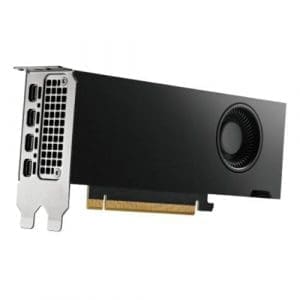
PNY RTX4000 SFF Ada Lovelace Professional Graphics Card, 20GB DDR6, 4 miniDP (DP adapter), 6144 CUDA Cores, Dual-Slot, Low Profile, Retail
£1,381.72 Read moreQuick View -
£1,332.70
Performance for Endless Possibilities
The NVIDIA RTX 4000 Ada Generation is the most powerful single-slot GPU for professionals, providing massive breakthroughs in speed and power efficiency over the previous generation to tackle demanding creative, design, and engineering workflows from the desktop. Harnessing the latest-generation RT Cores, Tensor Cores, and CUDA® cores alongside 20GB of graphics memory, RTX 4000 empowers professionals to create intricate product engineering, visionary cityscapes, and immersive entertainment experiences. With its power-efficient, single-slot design, RTX 4000 seamlessly fits into various workstation chassis, offering limitless potential for professionals.NVIDIA Ada Lovelace ArchitectureExperience fast, interactive performance—powered by the latest NVIDIA Ada Lovelace architecture-based GPU—with ultra-fast, onboard graphics memory technology and optimized software drivers for professional applications. The Shader Execution Reordering (SER) system allows on-the-fly organization and reordering of workloads, grouping similar performing threads so the streaming multiprocessor (SM) and RT Core can operate more efficiently.CUDA CoresThe NVIDIA Ada Lovelace architecture-based CUDA cores deliver up to 2X the single-precision floating-point (FP32) throughput compared to the previous generation, providing significant performance improvements for graphics workflows such as 3D model development and compute for workloads like desktop simulation for CAE.Third-Generation RT CoresThird-generation RT Cores provide up to 2X the throughput of the previous generation and the ability to run ray tracing with either shading or denoising capabilities concurrently. This accelerates renders for M&E content creation, AECO design evaluations, and manufacturing virtual prototyping. Third-generation RT Cores deliver up to 2X the ray-tracing performance over the previous generation, delivering groundbreaking performance for photorealistic rendering. Enhanced RT Cores combined with new SER technology dynamically reorder inefficient workloads, dramatically improving shader performance to accelerate end-to-end ray-traced image rendering performance.Fourth Generation Tensor CoresFourth-generation Tensor Cores provide up to 4X faster AI training performance than the previous generation with FP16 precision. Support for the new FP8 data format for inference provides more than 4X faster performance than the previous generation and reduces data memory usage by half (compared to the FP16 data format).PCIe Gen 4RTX 4000 supports PCIe Gen4, which doubles the bandwidth of PCIe Gen3 from 15.75GB/sec to 31.5 GB/sec for x16 connections, improving data transfer speeds from CPU memory for data-intensive tasks such as AI, data science, and creating 3D models from large datasets. Faster PCIe performance also accelerates GPU DMA transfers, providing faster video data transfers from GPUDirect for Video-enabled devices and faster IO with GPUDirect Storage.Higher Speed GDDR6 MemoryRTX 4000 features 20GB of GDDR6 memory, providing the memory needed for rendering, data science, engineering simulation, and other GPU memory-intensive applications. Support for ECC memory delivers uncompromised computing accuracy and reliability for mission-critical applications.Multi-DisplayFour mini-DisplayPort 1.4a connectors, support for multiple 8K monitors, NVIDIA Quadro Sync, Mosaic, and Warp and Blend enable massive immersive environments for CAVE, video walls, and location-based entertainment deployments.Extended RealitySupport for the latest high-resolution HMD devices, high-performance graphics, and 20GB of GPU memory enable the creation of AR and VR experiences for training, product validations, building walkthroughs, and compelling entertainment.Form Factor and Power EfficiencyWith a single-slot, low-profile form factor, and power-efficient design, RTX 4000 fits into a wide range of workstation chassis, providing professionals with a generous selection of compatible workstations from worldwide OEM vendors and delivering a groundbreaking GPU architecture for AI and AI-based neural graphics in desktop workstations.Motion BVHHardware-accelerated rendering of motion blur—a common cinematic effect that's difficult to render—means artists no longer need to rely on traditional methods of using motion vectors to achieve motion blur. Motion vectors allow the artist to adjust motion blur in post but require visual fixes for reflections and translucency.NVIDIA DLSSThe Ada Lovelace GPU architecture features a new Optical Flow Accelerator and AI-based DLSS Super Resolution with DL denoiser that boost DLSS 3.0's frame rates up to 4X compared to the previous version while maintaining or exceeding native image quality.NVIDIA RTX Broadcast EngineThe NVIDIA RTX Broadcast Engine transforms offices into broadcast studios, upgrading standard webcams and microphones into premium smart devices with the power of AI. Improve the video and audio quality of live streams with AI capabilities such as virtual backgrounds, webcam auto frame, and microphone noise removal. With dedicated AI processors called Tensor Cores on NVIDIA RTX GPUs, the AI networks can run in real-time alongside your applications.NVIDIA RTX ExperienceNVIDIA RTX Experience delivers a suite of productivity tools to your desktop workstation, including desktop recording in up to 8K, automatic alerts for the latest NVIDIA RTX Enterprise driver updates, and access gaming features. The application is available for download here.NVIDIA CUDA Parallel Computing PlatformNatively execute standard programming languages like C/C++ and Fortran, and APIs such as OpenCL, OpenACC, and Direct Compute to accelerate techniques such as ray tracing, video and image processing, and computation fluid dynamics.Unified MemoryA single, seamless 49-bit virtual address space allows for the transparent migration of data between the full allocation of CPU and GPU memory.NVIDIA GPU Direct for VideoGPUDirect for Video speeds communication between the GPU and video I/O devices by avoiding unnecessary system memory copies and CPU overhead.NVIDIA Enterprise Management ToolsMaximize system uptime, seamlessly manage wide-scale deployments, and remotely control graphics and display settings for efficient operations.7 in stock
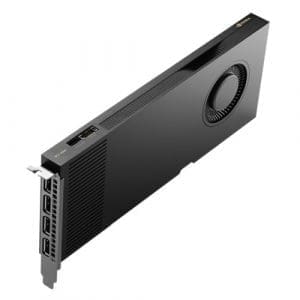
PNY RTX4000 Ada Lovelace Professional Graphics Card, 20GB DDR6, 4 DP, 6144 CUDA Cores, Single-Slot, OEM (Brown Box)
£1,332.70 Add to basketQuick View -
£1,312.64
Power for Endless Performance
In recent years, the demand for smaller footprint workstations has been skyrocketing, fueled by an array of factors, including cutting-edge hardware advancements, the extreme miniaturization of components, an increase in remote and mobile workforces, and the need for more energy efficient solutions suited for space available in modern offices and data centers. To meet this growing demand, NVIDIA has introduced the NVIDIA RTX™ 4000 SFF Ada Generation, the most powerful GPU on the market for Small Form Factor (SFF) workstations. Built on the revolutionary NVIDIA Ada Lovelace GPU architecture, the RTX 4000 SFF Ada brings new levels of performance, features, and capabilities to compact workstations, continuing to drive the evolution of visual computing for professionals. Designed for the needs of artists, architects, designers, and engineers across industries, the RTX 4000 SFF Ada is the ultimate compact computing solution to help you take your work to the next level.NVIDIA Ada Lovelace ArchitectureNVIDIA RTX 4000 SFF Ada is the most powerful dual slot, low profile workstation GPU offering high-performance, real-time ray tracing, AI-accelerated compute, and professional graphics rendering, all of this in a compact design with unmatched performance. Building upon the major SM enhancements from the Ada Lovelace GPU, the NVIDIA Ada Lovelace architecture provides more cores, higher clocks, and a larger L2 cache for more performance to enhance ray tracing operations, tensor matrix operations, and frame rates with DLSS 3.0.CUDA CoresThe NVIDIA Ada Lovelace architecture-based CUDA Cores offer more than 2X the single-precision floating point (FP32) throughput compared to the previous generation, providing significant performance improvements for graphics workflows such as 3D model development and compute for workloads such as desktop simulation for computer-aided engineering (CAE). The RTX 4000 SFF Ada enables two FP32 primary data paths, doubling the peak FP32 operations.Third Generation RT CoresIncorporating 3rd generation ray tracing engines, NVIDIA Ada Lovelace architecture-based GPUs provide incredible ray-traced rendering performance. A single NVIDIA RTX 4000 SFF Ada board can render complex professional models with physically accurate shadows, reflections, and refractions to empower users with instant insight. Working in concert with applications leveraging APIs such as NVIDIA OptiX, Microsoft DXR, and Vulkan ray tracing, systems based on the NVIDIA RTX 4000 SFF Ada will power truly interactive design workflows to provide immediate feedback for unprecedented levels of productivity. The NVIDIA RTX 4000 SFF Ada features up to 2X faster ray-triangle intersection throughput compared to the previous generation.Fourth Generation Tensor CoresSpecialized for deep learning matrix multiply and accumulate math operations at the heart of neural network training and inferencing functions, the NVIDIA RTX 4000 SFF Ada includes enhanced Tensor Cores that accelerate more data types and still support the Fine-Grained Structured Sparsity feature that delivers more than 2X throughput for tensor matrix operations compared to the previous generation. New Tensor Cores will accelerate new FP8 precision modes. Independent floating-point and integer data paths allow more efficient execution of workloads using a mix of computation and addressing calculations.PCIe Gen 4The NVIDIA RTX 4000 SFF Ada supports PCI Express Gen 4, which provides double the bandwidth of PCIe Gen 3, improving data-transfer speeds from CPU memory for data-intensive tasks like AI and data science.Higher Speed GDDR6 MemoryBuilt with 20GB GDDR6 memory, the NVIDIA RTX 4000 SFF Ada provides an ideal memory footprint to address datasets and models in latency-sensitive professional applications and at volume.Error Correcting Code (ECC) on Graphics MemoryMeet strict data integrity requirements for mission-critical applications with uncompromised computing accuracy and reliability for workstations.Fifth Generation NVDEC EngineNVDEC is well suited for transcoding and video playback applications for real-time decoding. The following video codecs are supported for hardware-accelerated decoding: MPEG-2, VC-1, H.264 (AVCHD), H.265 (HEVC), VP8, VP9, and AV1 video formats. Video encoding at 8K/60 will be achievable for professional video editing.Eighth Generation NVENC EngineNVENC can take on the most demanding 4K or 8K video encoding tasks to free up the graphics engine and the CPU for other operations. The NVIDIA RTX 4000 SFF Ada provides better encoding quality than software-based x264 encoders. The NVIDIA RTX 4000 SFF Ada incorporates AV1 video encoding which is 40% more efficient than H.264 encoding for 4K HDR video. AV1 will provide better quality at the same bitrate bandwidth.Graphics PreemptionPixel-level preemption provides more granular control to better support time-sensitive tasks such as VR motion tracking.Compute PreemptionPreemption at the instruction level provides finer-grain control over compute tasks to prevent long-running applications from either monopolizing system resources or timing out.Out of stock
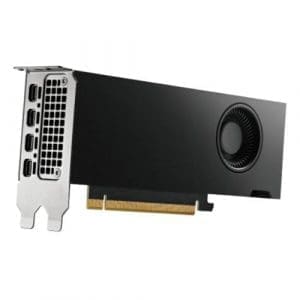
PNY RTX4000 SFF Ada Lovelace Professional Graphics Card, 20GB DDR6, 4 miniDP, 6144 CUDA Cores, Dual-Slot, Low Profile, OEM (Brown Box)
£1,312.64 Read moreQuick View -
£1,023.17
Sleek Design. Powerful Performance.
The NVIDIA Ampere architecture builds on the power of NVIDIA RTX to deliver the next generation of accelerated visual computing. As millions of professionals continue to work from anywhere, they rely on a wide range of devices to deliver the power and performance they need to work effectively.The NVIDIA RTX A4000 is the most powerful single-slot GPU for professionals, delivering real-time ray tracing, AI-accelerated compute, and high-performance graphics performance to your desktop. Built on the NVIDIA Ampere architecture, the RTX A4000 combines 48 second-generation RT Cores, 192 third-generation Tensor Cores, and 6144 CUDA cores with 16 GB of graphics memory. So you can engineer next-generation products, design cityscapes of the future, and create immersive entertainment experiences of tomorrow, today, from your desktop workstation. And with a power-efficient, single-slot PCIe form factor that fits into a wide range of workstation chassis, you can do exceptional work without limits.Performance And Useability FeaturesNVIDIA Ampere ArchitectureThe NVIDIA RTX A4000 is the one of the most powerful workstation GPUs NVIDIA offers, bringing high performance real-time ray tracing, AI-accelerated compute, and professional graphics rendering to demanding professionals. Building upon the major SM (Streaming Multiprocessor) enhancements from the Turing GPU, the NVIDIA Ampere architecture enhances ray tracing operations, tensor matrix operations, and concurrent executions of FP32 and INT32 operations.CUDA CoresThe NVIDIA Ampere architecture-based CUDA cores bring up to 2x the single-precision floating point (FP32) throughput compared to the previous generation, providing significant performance improvements for graphics workflows such as 3D model development and compute for workloads such as desktop simulation for computer-aided engineering (CAE). The RTX A4000 enables two FP32 primary data paths, doubling the peak FP32 operations.Second Generation RT CoresIncorporating second generation ray tracing engines, NVIDIA Ampere architecture-based GPUs provide incredible ray traced rendering performance. A single RTX A4000 board can render complex professional models with physically accurate shadows, reflections, and refractions to empower users with instant insight. Working in concert with applications leveraging APIs such as NVIDIA OptiX, Microsoft DXR and Vulkan ray tracing, systems based on the RTX A4000 will power truly interactive design workflows to provide immediate feedback for unprecedented levels of productivity. The RTX A4000 is up to 2x faster in ray tracing compared to the previous generation. This technology also speeds up the rendering of ray-traced motion blur for faster results with greater visual accuracy.Third Generation Tensor CoresPurpose-built for deep learning matrix arithmetic at the heart of neural network training and inferencing functions, the RTX A4000 includes enhanced Tensor Cores that accelerate more datatypes, and includes a new Fine-Grained Structured Sparsity feature that delivers up to 2X throughput for tensor matrix operations compared to the previous generation. New Tensor Cores will accelerate two new TF32 and BFloat16 precision modes. Independent floating-point and integer data paths allow more efficient execution of workloads using a mix of computation and addressing calculations.PCIe Gen 4The RTX A4000 supports PCI Express Gen 4, which provides double the bandwidth of PCIe Gen 3, improving data-transfer speeds from CPU memory for data-intensive tasks like AI and data science.Higher Speed GDDR6 MemoryBuilt with 16 GB GDDR6 memory delivering up to 23% greater throughput for ray tracing, rendering, and AI workloads than the previous generation. The RTX A4000 provides a capacious graphics memory footprint to address the largest datasets and models in latency-sensitive professional applications.Error Correcting Code (ECC) on Graphics MemoryMeet strict data integrity requirements for mission critical applications with uncompromised computing accuracy and reliability for workstations.Fifth Generation NVDEC EngineNVDEC is well suited for transcoding and video playback applications for real-time decoding. The following video codecs are supported for hardware-accelerated decoding: MPEG-2, VC-1, H.264 (AVCHD), H.265 (HEVC), VP8, VP9, and AV1.Seventh Generation NVENC EngineNVENC can take on the most demanding 4K or 8K video encoding tasks to free up the graphics engine and the CPU for other operations. The RTX A4000 provides better encoding quality than software-based x264 encoders.Graphics PreemptionPixel-level preemption provides more granular control to better support time-sensitive tasks such as VR motion tracking.Compute PreemptionPreemption at the instruction-level provides finer grain control over compute tasks to prevent long-running applications from either monopolizing system resources or timing out.NVIDIA RTX IOAccelerating GPU-based lossless decompression performance by up to 100x and 20x lower CPU utilization compared to traditional storage APIs using Microsoft’s new DirectStorage for Windows API. RTX IO moves data from the storage to the GPU in a more efficient, compressed form, and improving I/O performance.Multi-GPU Technology SupportNVIDIA SLI TechnologyLeverage multiple GPUs to dynamically scale graphics performance, enhance image quality, expand display real estate, and assemble a fully virtualized system.Display FeaturesNVIDIA Mosaic™ TechnologyTransparently scale the desktop and applications across up to 4 GPUs and 16 displays from a single workstation while delivering full performance and image quality.DisplayPort 1.4aSupport up to four 5K monitors at 60Hz, or dual 8K displays at 60Hz per card. The RTX A4000 supports HDR color for 4K at 60Hz for 10/12b HEVC decode and up to 4K at 60Hz for 10b HEVC encode. Each DisplayPort connector can drive ultra-high resolutions of 4096 x 2160 at 120 Hz with 30-bit color.NVIDIA RTX Desktop ManagerGain unprecedented end-user control of the desktop experience for increased productivity in single large display or multi-display environments, especially in the current age of large, widescreen displays.NVIDIA Quadro Sync IISynchronize the display and image output of up to 32 displays from 8 GPUs (connected through two Sync II boards) in a single system, reducing the number of machines needed to create an advanced video visualization environment.Frame Lock Connector LatchEach frame lock connector is designed with a self-locking retention mechanism to secure its connection with the frame lock cable to provide robust connectivity and maximum productivity.OpenGL Quad Buffered Stereo SupportProvide a smooth and immersive 3D Stereo experience for professional applications.Ultra-High-Resolution Desktop SupportGet more Mosaic topology choices with high resolution displays devices with a 32K Max desktop size.Professional 3D Stereo SynchronizationRobust control of stereo effects through a dedicated connection to directly synchronize 3D stereo hardware to an NVIDIA RTX professional graphics card.Software SupportNVIDIA RTX ExperienceNVIDIA RTX Experience delivers a suite of productivity tools to your desktop workstation, including desktop recording in up to 8K, automatic alerts for the latest NVIDIA RTX Enterprise driver updates, and access gaming features.Software Optimized for AIDeep learning frameworks such as Caffe2, MXNet, CNTK, TensorFlow, and others deliver dramatically faster training times and higher multi-node training performance. GPU accelerated libraries such as cuDNN, cuBLAS, and TensorRT delivers higher performance for both deep learning inference and High- Performance Computing (HPC) applications.NVIDIA CUDA Parallel Computing PlatformNatively execute standard programming languages like C/C++ and Fortran, and APIs such as OpenCL, OpenACC and Direct Compute to accelerates techniques such as ray tracing, video and image processing, and computation fluid dynamics.Unified MemoryA single, seamless 49-bit virtual address space allows for the transparent migration of data between the full allocation of CPU and GPU memory.NVIDIA GPUDirect for VideoGPUDirect for Video speeds communication between the GPU and video I/O devices by avoiding unnecessary system memory copies and CPU overhead.NVIDIA Enterprise-Management ToolsMaximize system uptime, seamlessly manage wide-scale deployments, and remotely control graphics and display settings for efficient operations.Out of stock

PNY RTXA4000 Professional Graphics Card, 16GB DDR6, 4 DP (HDMI adapter), Ampere Ray Tracing, 6144 Cores, SLI Support, Retail
£1,023.17 Read moreQuick View -
£946.60
Sleek Design. Powerful Performance.
The NVIDIA Ampere architecture builds on the power of NVIDIA RTX to deliver the next generation of accelerated visual computing. As millions of professionals continue to work from anywhere, they rely on a wide range of devices to deliver the power and performance they need to work effectively.The NVIDIA RTX A4000 is the most powerful single-slot GPU for professionals, delivering real-time ray tracing, AI-accelerated compute, and high-performance graphics performance to your desktop. Built on the NVIDIA Ampere architecture, the RTX A4000 combines 48 second-generation RT Cores, 192 third-generation Tensor Cores, and 6144 CUDA cores with 16 GB of graphics memory. So you can engineer next-generation products, design cityscapes of the future, and create immersive entertainment experiences of tomorrow, today, from your desktop workstation. And with a power-efficient, single-slot PCIe form factor that fits into a wide range of workstation chassis, you can do exceptional work without limits.Performance And Useability FeaturesNVIDIA Ampere ArchitectureThe NVIDIA RTX A4000 is the one of the most powerful workstation GPUs NVIDIA offers, bringing high performance real-time ray tracing, AI-accelerated compute, and professional graphics rendering to demanding professionals. Building upon the major SM (Streaming Multiprocessor) enhancements from the Turing GPU, the NVIDIA Ampere architecture enhances ray tracing operations, tensor matrix operations, and concurrent executions of FP32 and INT32 operations.CUDA CoresThe NVIDIA Ampere architecture-based CUDA cores bring up to 2x the single-precision floating point (FP32) throughput compared to the previous generation, providing significant performance improvements for graphics workflows such as 3D model development and compute for workloads such as desktop simulation for computer-aided engineering (CAE). The RTX A4000 enables two FP32 primary data paths, doubling the peak FP32 operations.Second Generation RT CoresIncorporating second generation ray tracing engines, NVIDIA Ampere architecture-based GPUs provide incredible ray traced rendering performance. A single RTX A4000 board can render complex professional models with physically accurate shadows, reflections, and refractions to empower users with instant insight. Working in concert with applications leveraging APIs such as NVIDIA OptiX, Microsoft DXR and Vulkan ray tracing, systems based on the RTX A4000 will power truly interactive design workflows to provide immediate feedback for unprecedented levels of productivity. The RTX A4000 is up to 2x faster in ray tracing compared to the previous generation. This technology also speeds up the rendering of ray-traced motion blur for faster results with greater visual accuracy.Third Generation Tensor CoresPurpose-built for deep learning matrix arithmetic at the heart of neural network training and inferencing functions, the RTX A4000 includes enhanced Tensor Cores that accelerate more datatypes, and includes a new Fine-Grained Structured Sparsity feature that delivers up to 2X throughput for tensor matrix operations compared to the previous generation. New Tensor Cores will accelerate two new TF32 and BFloat16 precision modes. Independent floating-point and integer data paths allow more efficient execution of workloads using a mix of computation and addressing calculations.PCIe Gen 4The RTX A4000 supports PCI Express Gen 4, which provides double the bandwidth of PCIe Gen 3, improving data-transfer speeds from CPU memory for data-intensive tasks like AI and data science.Higher Speed GDDR6 MemoryBuilt with 16 GB GDDR6 memory delivering up to 23% greater throughput for ray tracing, rendering, and AI workloads than the previous generation. The RTX A4000 provides a capacious graphics memory footprint to address the largest datasets and models in latency-sensitive professional applications.Error Correcting Code (ECC) on Graphics MemoryMeet strict data integrity requirements for mission critical applications with uncompromised computing accuracy and reliability for workstations.Fifth Generation NVDEC EngineNVDEC is well suited for transcoding and video playback applications for real-time decoding. The following video codecs are supported for hardware-accelerated decoding: MPEG-2, VC-1, H.264 (AVCHD), H.265 (HEVC), VP8, VP9, and AV1.Seventh Generation NVENC EngineNVENC can take on the most demanding 4K or 8K video encoding tasks to free up the graphics engine and the CPU for other operations. The RTX A4000 provides better encoding quality than software-based x264 encoders.Graphics PreemptionPixel-level preemption provides more granular control to better support time-sensitive tasks such as VR motion tracking.Compute PreemptionPreemption at the instruction-level provides finer grain control over compute tasks to prevent long-running applications from either monopolizing system resources or timing out.NVIDIA RTX IOAccelerating GPU-based lossless decompression performance by up to 100x and 20x lower CPU utilization compared to traditional storage APIs using Microsoft’s new DirectStorage for Windows API. RTX IO moves data from the storage to the GPU in a more efficient, compressed form, and improving I/O performance.Multi-GPU Technology SupportNVIDIA SLI TechnologyLeverage multiple GPUs to dynamically scale graphics performance, enhance image quality, expand display real estate, and assemble a fully virtualized system.Display FeaturesNVIDIA Mosaic™ TechnologyTransparently scale the desktop and applications across up to 4 GPUs and 16 displays from a single workstation while delivering full performance and image quality.DisplayPort 1.4aSupport up to four 5K monitors at 60Hz, or dual 8K displays at 60Hz per card. The RTX A4000 supports HDR color for 4K at 60Hz for 10/12b HEVC decode and up to 4K at 60Hz for 10b HEVC encode. Each DisplayPort connector can drive ultra-high resolutions of 4096 x 2160 at 120 Hz with 30-bit color.NVIDIA RTX Desktop ManagerGain unprecedented end-user control of the desktop experience for increased productivity in single large display or multi-display environments, especially in the current age of large, widescreen displays.NVIDIA Quadro Sync IISynchronize the display and image output of up to 32 displays from 8 GPUs (connected through two Sync II boards) in a single system, reducing the number of machines needed to create an advanced video visualization environment.Frame Lock Connector LatchEach frame lock connector is designed with a self-locking retention mechanism to secure its connection with the frame lock cable to provide robust connectivity and maximum productivity.OpenGL Quad Buffered Stereo SupportProvide a smooth and immersive 3D Stereo experience for professional applications.Ultra-High-Resolution Desktop SupportGet more Mosaic topology choices with high resolution displays devices with a 32K Max desktop size.Professional 3D Stereo SynchronizationRobust control of stereo effects through a dedicated connection to directly synchronize 3D stereo hardware to an NVIDIA RTX professional graphics card.Software SupportNVIDIA RTX ExperienceNVIDIA RTX Experience delivers a suite of productivity tools to your desktop workstation, including desktop recording in up to 8K, automatic alerts for the latest NVIDIA RTX Enterprise driver updates, and access gaming features.Software Optimized for AIDeep learning frameworks such as Caffe2, MXNet, CNTK, TensorFlow, and others deliver dramatically faster training times and higher multi-node training performance. GPU accelerated libraries such as cuDNN, cuBLAS, and TensorRT delivers higher performance for both deep learning inference and High- Performance Computing (HPC) applications.NVIDIA CUDA Parallel Computing PlatformNatively execute standard programming languages like C/C++ and Fortran, and APIs such as OpenCL, OpenACC and Direct Compute to accelerates techniques such as ray tracing, video and image processing, and computation fluid dynamics.Unified MemoryA single, seamless 49-bit virtual address space allows for the transparent migration of data between the full allocation of CPU and GPU memory.NVIDIA GPUDirect for VideoGPUDirect for Video speeds communication between the GPU and video I/O devices by avoiding unnecessary system memory copies and CPU overhead.NVIDIA Enterprise-Management ToolsMaximize system uptime, seamlessly manage wide-scale deployments, and remotely control graphics and display settings for efficient operations.Out of stock

PNY RTXA4000 Professional Graphics Card, 16GB DDR6, 6144 Cores, 4 DP, Ampere Ray Tracing, 6144 Core, SLI Support, OEM (Brown Box)
£946.60 Read moreQuick View -
£915.11
Essential Professional Graphics For Maximum Productivity
- 2x RJ-45 Frame Lock connectors
- BNC Genlock connector
- Status indicator LEDs
- 4 sync edge connectors
- Supports up to 81 Quadro GPUs
- Projector Overlap
- Stereoscopic 3D Support
- PCIe or SATA Power
- Secure cable
The NVIDIA Quadro Sync II card provides the solution for the advanced synchronized display requirements. The Quadro Sync II card can synchronize up to 4 Pascal GPUs per card for 16 synchronized displays per Sync II card, and with 2 Sync II cards per system, up to 8 Pascal GPUs per chassis for a total of 32 synchronized displays per system. The NVIDIA Quadro Sync II card combined with Quadro Pascal-based GPU graphics is the solution for professional synchronized display deployments.
Benefits
- The ability to synchronize the display outputs from 4 Quadro GPUs for a total of 16 synchronized displays per Sync II cards
- Two Sync II cards per chassis can provide up to 32 synchronized displays per chassis.
- Sync II cards can be connected to Sync II cards in another chassis to synchronize displays between systems in visualization clusters.
- Sync II cards can be connected to an external timing signal, synchronizing the output of the GPUs connected to the Sync II card to the external timing.
- Mosaic technology enables up to 16 displays or projectors per systems or per cluster to act like a single large virtual display. The Sync II card can synchronize the 16 displays for Mosaic to provide artifact free images across all 16 displays.
- Create multi-display stereoscopic visualization clusters
- Seamlessly blend multi projector solutions with no visual artifacts
- Support up to two Mosaics. Two Quadro Sync II connected together with the 2 × 7 header can support one to four Mosaics.
Out of stock

PNY NVidia Quadro Sync II Board – Synchronize up to 4 Pascal GPUs per Card, PCIe, 2x RJ-45 Frame Lock, BNC Genlock connector
£915.11 Read moreQuick View -
£702.92
Performance for endless possibilities.
Generative AI has revolutionized creative and technical workflows, ushering in a new era of computing. Its impact spans industries, from language processing to digital biology, manufacturing, and robotics. NVIDIA RTX leverages AI and ray tracing to deliver unprecedented levels of realism in graphics, while DLSS 3 introduces breakthroughs in AI-powered graphics. Additionally, NVIDIA Omniverse Enterprise bridges the gap between physical and digital worlds, enabling software-defined industries and fostering collaboration among large, highly skilled teams.As professionals navigate this transformative wave of generative AI and accelerated computing, equipping them with powerful solutions becomes paramount. NVIDIA RTX solutions enable professionals to harness the full potential of AI and graphics, driving innovation and pushing the boundaries of what is possible. By providing professionals with the necessary tools and technologies, they can confidently take on this next wave of AI and graphics, unlocking new levels of creativity and productivity.The NVIDIA RTX 2000 Ada Generation brings the cutting-edge Ada Lovelace architecture to more professionals, whether they use compact workstations or expansive full-sized towers, offering faster performance, advanced features, and up to 16GB of GPU memory. With its powerful low-profile, dual-slot form factor, you can do your life's work on a wide range of systems and free from limitations.NVIDIA Ada Lovelace ArchitectureThe NVIDIA RTX™ 2000 Ada Generation, based on the Ada Lovelace architecture, gives professionals the power of the latest RTX technology for accelerated ray tracing and AI to drive advanced visualization, creative, and design workflows for mainstream applications.CUDA CoresThe NVIDIA Ada Lovelace architecture-based CUDA Cores deliver up to 1.5X the single-precision floating-point (FP32) throughput compared to the previous generation, providing significant performance improvements for graphics workflows such as 3D model development and single-precision compute for workloads like desktop simulation for CAE.Third-Generation RT CoresThird-generation RT cores in the RTX 2000 provide up to 1.7X faster ray tracing performance over the previous generation, significantly boosting rendering speeds for content creation, design reviews, and virtual manufacturing prototyping. Enhanced RT cores and Shader Execution Reordering (SER) technology optimize shader performance, further accelerating ray traced image rendering.Fourth-Generation Tensor CoresFourth-generation Tensor Cores provide support for the new FP8 data format for inference providing up to 1.8X higher throughput for tensor matrix operations than the previous generation and reducing data memory usage by half compared to the FP16 data format for more efficient execution of workloads using a mix of computation and addressing calculations.PCIe Gen 4The RTX 2000 supports PCIe Gen 4, which doubles the bandwidth of PCIe Gen3 from 15.75GB/sec to 31.5 GB/sec for x8 connections, improving data transfer speeds from CPU memory for data-intensive tasks such as AI, data science, and creating 3D models from large datasets. RTX 2000 Ada Generation utilizes a full-length PCIe Gen 4 x8 interface.Higher Speed GDDR6 MemoryThe RTX 2000 features 16GB of GDDR6 memory, providing the memory needed for rendering, data science, engineering simulation, and other GPU memory-intensive applications. Support for ECC memory delivers uncompromised computing accuracy and reliability for mission-critical applications.Error Correcting Code (ECC) on Graphics MemoryECC on graphics memory detects and corrects data corruption in memory, meeting strict data integrity requirements for mission-critical applications with uncompromised computing accuracy and reliability for workstations.Fifth-Generation NVDEC EngineNVDEC is well-suited for transcoding and video playback applications for real-time decoding. The following codecs are supported for hardware-accelerated decoding: MPEG-2, VC-1, H.264 (AVCHD), H.265 (HEVC), VP8, VP9, and AV1.Eighth-Generation NVENC EngineNVENC can take on the most demanding 4K or 8K video encoding tasks to free up the graphics engine and the CPU for other operations. The RTX 2000 provides better encoding quality than software-based x264 encoders. The RTX 2000 incorporates AV1 video encoding which is 40% more efficient than H.264 encoding for 4K HDR video. AV1 will provide better quality at the same bitrate bandwidth.Graphics PreemptionPixel-level preemption provides more granular control to better support time-sensitive tasks such as VR motion tracking.Compute PreemptionPreemption at the instruction level provides finer grain control over compute tasks to prevent long-running applications from either monopolizing system resources or timing out.NVIDIA RTX IOAccelerating GPU-based lossless decompression performance by up to 100x and 20x lower CPU utilization compared to traditional storage APIs using Microsoft’s new DirectStorage for Windows API. RTX IO moves data from the storage to the GPU in a more efficient, compressed form, and improves I/O performance.NVIDIA® Mosaic TechnologyTransparently scale the desktop and applications across up to 4 GPUs and 16 displays from a single workstation while delivering full performance and image quality.DisplayPort 1.4aSupport up to four 5K monitors at 60Hz, or dual 8K displays at 60Hz per card. The RTX 2000 supports HDR color for 4K at 60Hz for 10/12b HEVC decode and up to 4K at 60Hz for 10b HEVC encode. Each DisplayPort connector can drive ultra-high resolutions of 4096 x 2160 at 120 Hz with 30-bit color.NVIDIA RTX Desktop ManagerGain unprecedented end-user control of the desktop experience for increased productivity in single large display or multi-display environments, especially in the current age of large, widescreen displays.OpenGL Quad Buffered Stereo SupportProvide a smooth and immersive 3D Stereo experience for professional applications.Ultra-High-Resolution Desktop SupportGet more Mosaic topology choices with high-resolution display devices with a 32K max desktop size.NVIDIA RTX ExperienceNVIDIA RTX Experience delivers a suite of productivity tools to your desktop workstation, including desktop recording in up to 8K, automatic alerts for the latest NVIDIA RTX Enterprise driver updates, and access to gaming features. The application is available for download here.Software Optimized for AIDeep learning frameworks such as Caffe2, MXNet, CNTK, TensorFlow, and others deliver dramatically faster training times and higher multi-node training performance. GPU-accelerated libraries such as cuDNN, cuBLAS, and TensorRT deliver higher performance for both deep learning inference and High-Performance Computing (HPC) applications.NVIDIA CUDA Parallel Computing PlatformNatively execute standard programming languages like C/C++ and Fortran, and APIs such as OpenCL, OpenACC and Direct Compute to accelerate techniques such as ray tracing, video and image processing, and computation fluid dynamics.Unified MemoryA single, seamless 49-bit virtual address space allows for the transparent migration of data between the full allocation of CPU and GPU memory.NVIDIA Enterprise-Management ToolsMaximize system uptime, seamlessly manage wide-scale deployments, and remotely control graphics and display settings for efficient operations.3 in stock

PNY RTX2000 Ada Professional Graphics Card, 16GB DDR6, 4 Mini DP (DP Adapter), 2816, CUDA Cores, Dual-Slot, Low Profile, Retail
£702.92 Add to basketQuick View -
£660.16
Performance for endless possibilities.
Generative AI has revolutionized creative and technical workflows, ushering in a new era of computing. Its impact spans industries, from language processing to digital biology, manufacturing, and robotics. NVIDIA RTX leverages AI and ray tracing to deliver unprecedented levels of realism in graphics, while DLSS 3 introduces breakthroughs in AI-powered graphics. Additionally, NVIDIA Omniverse Enterprise bridges the gap between physical and digital worlds, enabling software-defined industries and fostering collaboration among large, highly skilled teams.As professionals navigate this transformative wave of generative AI and accelerated computing, equipping them with powerful solutions becomes paramount. NVIDIA RTX solutions enable professionals to harness the full potential of AI and graphics, driving innovation and pushing the boundaries of what is possible. By providing professionals with the necessary tools and technologies, they can confidently take on this next wave of AI and graphics, unlocking new levels of creativity and productivity.The NVIDIA RTX 2000 Ada Generation brings the cutting-edge Ada Lovelace architecture to more professionals, whether they use compact workstations or expansive full-sized towers, offering faster performance, advanced features, and up to 16GB of GPU memory. With its powerful low-profile, dual-slot form factor, you can do your life's work on a wide range of systems and free from limitations.NVIDIA Ada Lovelace ArchitectureThe NVIDIA RTX™ 2000 Ada Generation, based on the Ada Lovelace architecture, gives professionals the power of the latest RTX technology for accelerated ray tracing and AI to drive advanced visualization, creative, and design workflows for mainstream applications.CUDA CoresThe NVIDIA Ada Lovelace architecture-based CUDA Cores deliver up to 1.5X the single-precision floating-point (FP32) throughput compared to the previous generation, providing significant performance improvements for graphics workflows such as 3D model development and single-precision compute for workloads like desktop simulation for CAE.Third-Generation RT CoresThird-generation RT cores in the RTX 2000 provide up to 1.7X faster ray tracing performance over the previous generation, significantly boosting rendering speeds for content creation, design reviews, and virtual manufacturing prototyping. Enhanced RT cores and Shader Execution Reordering (SER) technology optimize shader performance, further accelerating ray traced image rendering.Fourth-Generation Tensor CoresFourth-generation Tensor Cores provide support for the new FP8 data format for inference providing up to 1.8X higher throughput for tensor matrix operations than the previous generation and reducing data memory usage by half compared to the FP16 data format for more efficient execution of workloads using a mix of computation and addressing calculations.PCIe Gen 4The RTX 2000 supports PCIe Gen 4, which doubles the bandwidth of PCIe Gen3 from 15.75GB/sec to 31.5 GB/sec for x8 connections, improving data transfer speeds from CPU memory for data-intensive tasks such as AI, data science, and creating 3D models from large datasets. RTX 2000 Ada Generation utilizes a full-length PCIe Gen 4 x8 interface.Higher Speed GDDR6 MemoryThe RTX 2000 features 16GB of GDDR6 memory, providing the memory needed for rendering, data science, engineering simulation, and other GPU memory-intensive applications. Support for ECC memory delivers uncompromised computing accuracy and reliability for mission-critical applications.Error Correcting Code (ECC) on Graphics MemoryECC on graphics memory detects and corrects data corruption in memory, meeting strict data integrity requirements for mission-critical applications with uncompromised computing accuracy and reliability for workstations.Fifth-Generation NVDEC EngineNVDEC is well-suited for transcoding and video playback applications for real-time decoding. The following codecs are supported for hardware-accelerated decoding: MPEG-2, VC-1, H.264 (AVCHD), H.265 (HEVC), VP8, VP9, and AV1.Eighth-Generation NVENC EngineNVENC can take on the most demanding 4K or 8K video encoding tasks to free up the graphics engine and the CPU for other operations. The RTX 2000 provides better encoding quality than software-based x264 encoders. The RTX 2000 incorporates AV1 video encoding which is 40% more efficient than H.264 encoding for 4K HDR video. AV1 will provide better quality at the same bitrate bandwidth.Graphics PreemptionPixel-level preemption provides more granular control to better support time-sensitive tasks such as VR motion tracking.Compute PreemptionPreemption at the instruction level provides finer grain control over compute tasks to prevent long-running applications from either monopolizing system resources or timing out.NVIDIA RTX IOAccelerating GPU-based lossless decompression performance by up to 100x and 20x lower CPU utilization compared to traditional storage APIs using Microsoft’s new DirectStorage for Windows API. RTX IO moves data from the storage to the GPU in a more efficient, compressed form, and improves I/O performance.NVIDIA® Mosaic TechnologyTransparently scale the desktop and applications across up to 4 GPUs and 16 displays from a single workstation while delivering full performance and image quality.DisplayPort 1.4aSupport up to four 5K monitors at 60Hz, or dual 8K displays at 60Hz per card. The RTX 2000 supports HDR color for 4K at 60Hz for 10/12b HEVC decode and up to 4K at 60Hz for 10b HEVC encode. Each DisplayPort connector can drive ultra-high resolutions of 4096 x 2160 at 120 Hz with 30-bit color.NVIDIA RTX Desktop ManagerGain unprecedented end-user control of the desktop experience for increased productivity in single large display or multi-display environments, especially in the current age of large, widescreen displays.OpenGL Quad Buffered Stereo SupportProvide a smooth and immersive 3D Stereo experience for professional applications.Ultra-High-Resolution Desktop SupportGet more Mosaic topology choices with high-resolution display devices with a 32K max desktop size.NVIDIA RTX ExperienceNVIDIA RTX Experience delivers a suite of productivity tools to your desktop workstation, including desktop recording in up to 8K, automatic alerts for the latest NVIDIA RTX Enterprise driver updates, and access to gaming features. The application is available for download here.Software Optimized for AIDeep learning frameworks such as Caffe2, MXNet, CNTK, TensorFlow, and others deliver dramatically faster training times and higher multi-node training performance. GPU-accelerated libraries such as cuDNN, cuBLAS, and TensorRT deliver higher performance for both deep learning inference and High-Performance Computing (HPC) applications.NVIDIA CUDA Parallel Computing PlatformNatively execute standard programming languages like C/C++ and Fortran, and APIs such as OpenCL, OpenACC and Direct Compute to accelerate techniques such as ray tracing, video and image processing, and computation fluid dynamics.Unified MemoryA single, seamless 49-bit virtual address space allows for the transparent migration of data between the full allocation of CPU and GPU memory.NVIDIA Enterprise-Management ToolsMaximize system uptime, seamlessly manage wide-scale deployments, and remotely control graphics and display settings for efficient operations.3 in stock

PNY RTX2000 Ada Professional Graphics Card, 16GB DDR6, 4 Mini DP, 2816, CUDA Cores, Dual-Slot, Low Profile, OEM (Brown Box)
£660.16 Add to basketQuick View -
£569.27
Compact Design. Unmatched Performance.
The NVIDIA RTX A2000 brings the power of NVIDIA RTX technology, real-time ray tracing, AI-accelerated compute, and high-performance graphics to more professionals. Built on the NVIDIA Ampere architecture, the VR ready RTX A2000 combines 26 second-generation RT Cores, 104 third-generation Tensor Cores, and 3,328 next-generation CUDA cores and 6GB of GDDR6 graphics memory with error correction code (ECC) support for error free computing. The RTX A2000 features a power-efficient low profile, dual-slot PCIe form factor that fits into a wide range of small form factor workstations. Design bigger, render faster, and work smarter than ever before with the RTX A2000.NVIDIA RTX cards are certified with a broad range of sophisticated professional applications, tested by leading workstation manufacturers, and backed by a global team of support specialists. This gives you the peace of mind to focus on doing your best work. Whether you're developing revolutionary products or telling spectacularly vivid visual stories, NVIDIA RTX gives you the performance to do it brilliantly.- CUDA Cores: 3328
- GPU Memory: 12 GB GDDR6 with ECC
- Memory Interface: 192-bit
- Memory Bandwidth: Up to 288 GB/s
- Display Connectors: mDP 1.4a (4)
- DisplayPort: 1.4 Yes
- Warranty: 3 Years
Performance and Useability FeaturesNVIDIA Ampere Architecture
NVIDIA RTX A2000 is the most powerful dual slot, low profile GPU solution offering high performance real-time ray tracing, AI-accelerated compute, and professional graphics rendering, all of this in a compact design with unmatched performance. Building upon the major SM enhancements from the Turing GPU, the NVIDIA Ampere architecture enhances ray tracing operations, tensor matrix operations, and concurrent executions of FP32 and INT32 operations.CUDA CoresThe NVIDIA Ampere architecture-based CUDA cores bring up to 2.7X the single-precision floating point (FP32) throughput compared to the previous generation, providing significant performance improvements for graphics workflows such as 3D model development and compute for workloads such as desktop simulation for computer-aided engineering (CAE). The RTX A2000 enables two FP32 primary data paths, doubling the peak FP32 operations.Second Generation RT CoresIncorporating 2nd generation ray tracing engines, NVIDIA Ampere architecture-based GPUs provide incredible ray traced rendering performance. For the first time NVDIA is introducing RT Cores into a low profile form factor GPU. A single RTX A2000 board can render complex professional models with physically accurate shadows, reflections, and refractions to empower users with instant insight. Working in concert with applications leveraging APIs such as NVIDIA OptiX, Microsoft DXR and Vulkan ray tracing, systems based on the RTX A2000 will power truly interactive design workflows to provide immediate feedback for unprecedented levels of productivity. The RTX A2000 is more than 5X faster in ray tracing compared to the previous generation. This technology also speeds up the rendering of ray-traced motion blur for faster results with greater visual accuracy.Third Generation Tensor CoresPurpose-built for deep learning matrix arithmetic at the heart of neural network training and inferencing functions, the RTX A2000 includes enhanced Tensor Cores that accelerate more datatypes and includes a new Fine-Grained Structured Sparsity feature that delivers more than 2X throughput for tensor matrix operations compared to the previous generation. New Tensor Cores will accelerate two new TF32 and BFloat16 precision modes. Independent floating-point and integer data paths allow more efficient execution of workloads using a mix of computation and addressing calculations.PCIe Gen 4The RTX A2000 supports PCI Express Gen 4, which provides double the bandwidth of PCIe Gen 3, improving data-transfer speeds from CPU memory for data-intensive tasks like AI and data science.Higher Speed GDDR6 MemoryBuilt with 6GB GDDR6 memory delivering up to 2X greater throughput for ray tracing, rendering, and AI workloads than the previous generation. The RTX A2000 provides ideal memory footprint to address the datasets and models in latency-sensitive professional applications and at volume.Error Correcting Code (ECC) on Graphics MemoryMeet strict data integrity requirements for mission critical applications with uncompromised computing accuracy and reliability for workstations.Fifth Generation NVDEC EngineNVDEC is well suited for transcoding and video playback applications for real-time decoding. The following video codecs are supported for hardware-accelerated decoding: MPEG-2, VC-1, H.264 (AVCHD), H.265 (HEVC), VP8, VP9, and AV1.Seventh Generation NVENC EngineNVENC can take on the most demanding 4K or 8K video encoding tasks to free up the graphics engine and the CPU for other operations. The RTX A2000 provides better encoding quality than software-based x264 encoders.Graphics PreemptionPixel-level preemption provides more granular control to better support time-sensitive tasks such as VR motion tracking.Compute PreemptionPreemption at the instruction-level provides finer grain control over compute tasks to prevent long- running applications from either monopolizing system resources or timing out.NVIDIA RTX IOAccelerating GPU-based lossless decompression performance by up to 100x and 20x lower CPU utilization compared to traditional storage APIs using Microsoft’s new DirectStorage for Windows API. RTX IO moves data from the storage to the GPU in a more efficient, compressed form, and improving I/O performance.Display FeaturesNVIDIA Mosaic Technology
Transparently scale the desktop and applications across up to 4 GPUs and 16 displays from a single workstation while delivering full performance and image quality.DisplayPort 1.4aSupport up to four 5K monitors at 60Hz, or dual 8K displays at 60Hz per card. The RTX A2000 supports HDR color for 4K at 60Hz for 10/12b HEVC decode and up to 4K at 60Hz for 10b HEVC encode. Each DisplayPort connector can drive ultra-high resolutions of 4096×2160 at 120 Hz with 30-bit color.NVIDIA RTX Desktop ManagerGain unprecedented end-user control of the desktop experience for increased productivity in single large display or multi-display environments, especially in the current age of large, widescreen displays.OpenGL Quad Buffered Stereo SupportProvides a smooth and immersive 3D Stereo experience for professional applications.Ultra-High-Resolution Desktop SupportGet more Mosaic topology choices with high resolution displays devices with a 32K Max desktop size.Professional 3D Stereo SynchronizationRobust control of stereo effects through a dedicated connection to directly synchronize 3D stereo hardware to an NVIDIA RTX professional graphics card.Software SupportNVIDIA RTX Experience
NVIDIA RTX Experience delivers a suite of productivity tools to your desktop workstation, including desktop recording in up to 8K, automatic alerts for the latest NVIDIA RTX Enterprise driver updates, and access gaming features. The application is available for download.Software Optimized for AIDeep learning frameworks such as Caffe2, MXNet, CNTK, TensorFlow, and others deliver dramatically faster training times and higher multi-node training performance. GPU accelerated libraries such as cuDNN, cuBLAS, and TensorRT delivers higher performance for both deep learning inference and High- Performance Computing (HPC) application.NVIDIA CUDA Parallel Computing PlatformNatively execute standard programming languages like C/C++ and Fortran, and APIs such as OpenCL, OpenACC and Direct Compute to accelerates techniques such as ray tracing, video and image processing, and computation fluid dynamics.Unified MemoryA single, seamless 49-bit virtual address space allows for the transparent migration of data between the full allocation of CPU and GPU memory.NVIDIA Enterprise-Management ToolsMaximize system uptime, seamlessly manage wide-scale deployments, and remotely control graphics and display settings for efficient operations.3 in stock
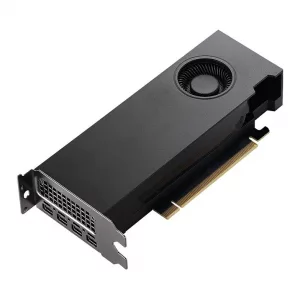
PNY RTXA2000 Professional Graphics Card, 12GB DDR6, 3328 Cores, 4 mDP (DP adapter), Low Profile, Retail
£569.27 Add to basketQuick View -
£523.15
Compact Design. Unmatched Performance.
The NVIDIA RTX A2000 brings the power of NVIDIA RTX technology, real-time ray tracing, AI-accelerated compute, and high-performance graphics to more professionals. Built on the NVIDIA Ampere architecture, the VR ready RTX A2000 combines 26 second-generation RT Cores, 104 third-generation Tensor Cores, and 3,328 next-generation CUDA cores and 6GB of GDDR6 graphics memory with error correction code (ECC) support for error free computing. The RTX A2000 features a power-efficient low profile, dual-slot PCIe form factor that fits into a wide range of small form factor workstations. Design bigger, render faster, and work smarter than ever before with the RTX A2000.NVIDIA RTX cards are certified with a broad range of sophisticated professional applications, tested by leading workstation manufacturers, and backed by a global team of support specialists. This gives you the peace of mind to focus on doing your best work. Whether you're developing revolutionary products or telling spectacularly vivid visual stories, NVIDIA RTX gives you the performance to do it brilliantly.- CUDA Cores: 3328
- GPU Memory: 12 GB GDDR6 with ECC
- Memory Interface: 192-bit
- Memory Bandwidth: Up to 288 GB/s
- Display Connectors: mDP 1.4a (4)
- DisplayPort: 1.4 Yes
- Warranty: 3 Years
Performance and Useability FeaturesNVIDIA Ampere Architecture
NVIDIA RTX A2000 is the most powerful dual slot, low profile GPU solution offering high performance real-time ray tracing, AI-accelerated compute, and professional graphics rendering, all of this in a compact design with unmatched performance. Building upon the major SM enhancements from the Turing GPU, the NVIDIA Ampere architecture enhances ray tracing operations, tensor matrix operations, and concurrent executions of FP32 and INT32 operations.CUDA CoresThe NVIDIA Ampere architecture-based CUDA cores bring up to 2.7X the single-precision floating point (FP32) throughput compared to the previous generation, providing significant performance improvements for graphics workflows such as 3D model development and compute for workloads such as desktop simulation for computer-aided engineering (CAE). The RTX A2000 enables two FP32 primary data paths, doubling the peak FP32 operations.Second Generation RT CoresIncorporating 2nd generation ray tracing engines, NVIDIA Ampere architecture-based GPUs provide incredible ray traced rendering performance. For the first time NVDIA is introducing RT Cores into a low profile form factor GPU. A single RTX A2000 board can render complex professional models with physically accurate shadows, reflections, and refractions to empower users with instant insight. Working in concert with applications leveraging APIs such as NVIDIA OptiX, Microsoft DXR and Vulkan ray tracing, systems based on the RTX A2000 will power truly interactive design workflows to provide immediate feedback for unprecedented levels of productivity. The RTX A2000 is more than 5X faster in ray tracing compared to the previous generation. This technology also speeds up the rendering of ray-traced motion blur for faster results with greater visual accuracy.Third Generation Tensor CoresPurpose-built for deep learning matrix arithmetic at the heart of neural network training and inferencing functions, the RTX A2000 includes enhanced Tensor Cores that accelerate more datatypes and includes a new Fine-Grained Structured Sparsity feature that delivers more than 2X throughput for tensor matrix operations compared to the previous generation. New Tensor Cores will accelerate two new TF32 and BFloat16 precision modes. Independent floating-point and integer data paths allow more efficient execution of workloads using a mix of computation and addressing calculations.PCIe Gen 4The RTX A2000 supports PCI Express Gen 4, which provides double the bandwidth of PCIe Gen 3, improving data-transfer speeds from CPU memory for data-intensive tasks like AI and data science.Higher Speed GDDR6 MemoryBuilt with 6GB GDDR6 memory delivering up to 2X greater throughput for ray tracing, rendering, and AI workloads than the previous generation. The RTX A2000 provides ideal memory footprint to address the datasets and models in latency-sensitive professional applications and at volume.Error Correcting Code (ECC) on Graphics MemoryMeet strict data integrity requirements for mission critical applications with uncompromised computing accuracy and reliability for workstations.Fifth Generation NVDEC EngineNVDEC is well suited for transcoding and video playback applications for real-time decoding. The following video codecs are supported for hardware-accelerated decoding: MPEG-2, VC-1, H.264 (AVCHD), H.265 (HEVC), VP8, VP9, and AV1.Seventh Generation NVENC EngineNVENC can take on the most demanding 4K or 8K video encoding tasks to free up the graphics engine and the CPU for other operations. The RTX A2000 provides better encoding quality than software-based x264 encoders.Graphics PreemptionPixel-level preemption provides more granular control to better support time-sensitive tasks such as VR motion tracking.Compute PreemptionPreemption at the instruction-level provides finer grain control over compute tasks to prevent long- running applications from either monopolizing system resources or timing out.NVIDIA RTX IOAccelerating GPU-based lossless decompression performance by up to 100x and 20x lower CPU utilization compared to traditional storage APIs using Microsoft’s new DirectStorage for Windows API. RTX IO moves data from the storage to the GPU in a more efficient, compressed form, and improving I/O performance.Display FeaturesNVIDIA Mosaic Technology
Transparently scale the desktop and applications across up to 4 GPUs and 16 displays from a single workstation while delivering full performance and image quality.DisplayPort 1.4aSupport up to four 5K monitors at 60Hz, or dual 8K displays at 60Hz per card. The RTX A2000 supports HDR color for 4K at 60Hz for 10/12b HEVC decode and up to 4K at 60Hz for 10b HEVC encode. Each DisplayPort connector can drive ultra-high resolutions of 4096×2160 at 120 Hz with 30-bit color.NVIDIA RTX Desktop ManagerGain unprecedented end-user control of the desktop experience for increased productivity in single large display or multi-display environments, especially in the current age of large, widescreen displays.OpenGL Quad Buffered Stereo SupportProvides a smooth and immersive 3D Stereo experience for professional applications.Ultra-High-Resolution Desktop SupportGet more Mosaic topology choices with high resolution displays devices with a 32K Max desktop size.Professional 3D Stereo SynchronizationRobust control of stereo effects through a dedicated connection to directly synchronize 3D stereo hardware to an NVIDIA RTX professional graphics card.Software SupportNVIDIA RTX Experience
NVIDIA RTX Experience delivers a suite of productivity tools to your desktop workstation, including desktop recording in up to 8K, automatic alerts for the latest NVIDIA RTX Enterprise driver updates, and access gaming features. The application is available for download.Software Optimized for AIDeep learning frameworks such as Caffe2, MXNet, CNTK, TensorFlow, and others deliver dramatically faster training times and higher multi-node training performance. GPU accelerated libraries such as cuDNN, cuBLAS, and TensorRT delivers higher performance for both deep learning inference and High- Performance Computing (HPC) application.NVIDIA CUDA Parallel Computing PlatformNatively execute standard programming languages like C/C++ and Fortran, and APIs such as OpenCL, OpenACC and Direct Compute to accelerates techniques such as ray tracing, video and image processing, and computation fluid dynamics.Unified MemoryA single, seamless 49-bit virtual address space allows for the transparent migration of data between the full allocation of CPU and GPU memory.NVIDIA Enterprise-Management ToolsMaximize system uptime, seamlessly manage wide-scale deployments, and remotely control graphics and display settings for efficient operations.27 in stock

PNY RTXA2000 Professional Graphics Card, 12GB DDR6, 3328 Cores, 4 mDP, Low Profile, OEM (Brown Box)
£523.15 Add to basketQuick View -
£433.94
Performance for endless possibilities.
Small-form-factor computing solutions are becoming more common as professionals look to minimize their desktop workstation footprint—without compromising performance. Today's professional workflows require small-form-factor workstations to provide full-size features and performance in a compact package.Built on NVIDIA Ampere GPU architecture, the NVIDIA RTX™ A1000 GPU is a powerful, low-profile solution that delivers the performance and capabilities required by demanding professional applications. With 2,304 CUDA® Cores, 18 RT Cores, 72 Tensor Cores, 8GB of GDDR6 memory, and the ability to drive up to four 5K displays, the NVIDIA RTX A1000 is ready to take your work to the next level.Key Features
- Second-generation RT Cores
- Third-generation Tensor Cores
- PCI Express Gen 4
- Four Mini DisplayPort 1.4a
- AV1 decode support
- DisplayPort with audio
- NVIDIA RTX Experience™
- NVIDIA RTX Desktop Manager software
- NVIDIA RTX IO support
- HDCP 2.2 support
- NVIDIA Mosaic1 technology
Nvidia RTX A1000 Use CasesArchitecture, Engineering, Construction, and OperationsRTX A1000 graphics cards are designed to empower professionals in architecture, engineering, and constructions with the ability to work with small to mid-sized 3D models used in conceptual design, BIM, and infrastructure planning. It's a great solution for professionals who need smoother manipulation of models, enabling them to explore their designs with greater easy and efficiency.Manufacturing and Product Development
RTX A1000 enables designers and engineers to build CAD models with more components and more complex assemblies, enabling them to bring their projects to life.Media and Entertainment
RTX A1000 is the ideal choice for creative professionals and hobbyists who need to cut, add transitions, and work with color correction in video projects. It effortlessly handles design software like Adobe Photoshop and Illustrator, enabling smooth creation of digital art, web graphics, and marketing materials.Designed for small-scale 3D modeling and rendering tasks in applications such as Blender, SketchUp, or Autodesk Maya, empowering users to unleash their creativity and bring their visions to life with more precision and realism.A powerful choice for digital creators producing content for social platforms, the RTX A1000 drives video editing, graphic design, and multimedia creation, delivering professionals-quality content that captivates audiences.19 in stock
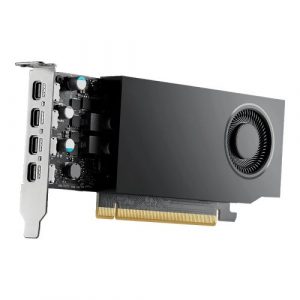
PNY RTXA1000 Professional Graphics Card, 8GB DDR6, 4 miniDP 1.4 (4x DP adapters), 2304 CUDA Cores, Low Profile (Bracket Included), Retail
£433.94 Add to basketQuick View -
£395.64
Full Performance in a Small Form Factor Solution
NVIDIA GPUs power the world's most advanced desktop workstations, providing the visual computing power required by millions of professionals as part of their daily workflow. All phases of the professional workflow, from creating, editing, and viewing 2D and 3D models and video, to working with multiple applications across several displays, benefit from the power that only a discreet GPU solution can provide. NVIDIA entry level professional GPUs provide advanced features and performance far beyond what is available with integrated GPU solutions – all in a low-profile package, enabling deployment in a wide range of small form factor workstations. Step up to the power of an NVIDIA discreet professional GPU.The NVIDIA Turing architecture provides significant performance improvements with NVIDIA T1000, resulting in more than 50% graphics performance, compared to the previous generation P1000. Ultra-fast GDDR6 graphics memory technology provides twice the memory bandwidth of the previous generation.- CUDA Cores: 896
- GPU Memory: 8 GB GDDR6
- Peak FP32 Performance: 2.50 TFLOPS
- Memory Interface: 128-bit
- Memory Bandwidth: 160 GB/s
- Max Power Consumption: 50 W
- System Interface: PCI Express 3.0 x16
- Display Connectors: 4x mDP
- Form Factor: Low-Profile Single Slot
- Thermal Solution: Active Fansink
NVIDIA T1000 Performance and FeaturesValue for End-Users- Powered by NVIDIA Turing GPU architecture, NVIDIA T1000 delivers more performance than the previous generation.
- Allows you to work with larger models, scenes, and assemblies, with higher levels of interactivity during design and visualization.
- Ensures hardware compatibility and stability through NVIDIA support of the latest OpenGL, DirectX, Vulkan, and NVIDIA CUDA standards, deep ISV developer engagements, and certification with over 100 professional software applications.
- Enables creation and playback of H.264 and HEVC video, with dedicated decode and encode engines that are independent of the 3D graphics and compute pipeline.
- With support for DisplayPort 1.4, NVIDIA T1000 can drive display resolutions for up to four 5K displays or two 8K displays per card. Combine up to four NVIDIA T1000s in a single system to create display walls or other immersive environments.
- Experience stunning visuals with HDR color support and up to 120 Hz refresh rates for 4K displays with 30-bit color.
Value for IT Administrators- Experience higher-quality products, driven by power-efficient hardware designs and component selection, for optimum operational performance, durability, and longevity.
- Expect maximum uptime thanks to exhaustive product testing in conjunction with leading OEMs and system integrators that simulate the most demanding real-world conditions.
- Remotely monitor and manage NVIDIA T1000s deployed in your enterprise by integrating the NVIDIA Enterprise Management toolkit within your IT asset management framework.
- Scale up NVIDIA T1000 deployment to hundreds of workstations using the powerful driver installer included with the NVIDIA Enterprise Management toolkit.
- Simplify software driver deployment through a regular cadence of long-life, stable driver releases based on a robust feature-development and quality-assurance process.
NVIDIA T1000 SolutionsManufacturing- Enables designers and engineers to create models with larger numbers of components and more complex assemblies.
- Offers support for up to three 4K displays for an expansive desktop that allows designers to work with multiple apps, simultaneously.
- Supports displays at up to 8K resolution. Combine multiple NVIDIA T1000 cards for massive visual workspaces.
Media and Entertainment- Allow editors to work in real time with HDR content and up to 5K full resolution.
- Enables artists working with 3D models or 2D imagery to realize better performance with assets stored in dedicated high-performance graphics memory.
- Creates and plays back ultra-high quality HDR content with H.264/HEVC encode and decode engines.
- Combine multiple NVIDIA T1000 cards to create expansive visual display solutions.
AEC- Allows architects to create larger models, view 2D and 3D designs and plans, in real-time, with no lag.
- Equips urban designers with the tools to create models with more detail and complexity.
Financial Services- Drives up to four 4K displays per card directly with onboard mini-DisplayPort latching connectors. Creates expansive visual environments with up to 16 total displays, using four NVIDIA T1000 cards per system.
- Manages multiple windows across multiple applications and desktops with NVIDIA RTX Desktop Manager software.
- Improves productivity by running multi-application workflows without performance impact.
- Uses minimal power, resulting in lower TCO.
Out of stock
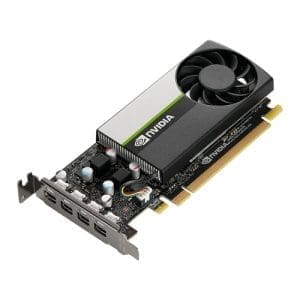
PNY T1000 Professional Graphics Card, 8GB DDR6, 896 Cores, 4 miniDP 1.4 (4 x DP adapters), Low Profile (Bracket Included), Retail
£395.64 Read moreQuick View -
£393.98
Performance for endless possibilities.
Small-form-factor computing solutions are becoming more common as professionals look to minimize their desktop workstation footprint—without compromising performance. Today's professional workflows require small-form-factor workstations to provide full-size features and performance in a compact package.Built on NVIDIA Ampere GPU architecture, the NVIDIA RTX™ A1000 GPU is a powerful, low-profile solution that delivers the performance and capabilities required by demanding professional applications. With 2,304 CUDA® Cores, 18 RT Cores, 72 Tensor Cores, 8GB of GDDR6 memory, and the ability to drive up to four 5K displays, the NVIDIA RTX A1000 is ready to take your work to the next level.Key Features
- Second-generation RT Cores
- Third-generation Tensor Cores
- PCI Express Gen 4
- Four Mini DisplayPort 1.4a
- AV1 decode support
- DisplayPort with audio
- NVIDIA RTX Experience™
- NVIDIA RTX Desktop Manager software
- NVIDIA RTX IO support
- HDCP 2.2 support
- NVIDIA Mosaic1 technology
Nvidia RTX A1000 Use CasesArchitecture, Engineering, Construction, and OperationsRTX A1000 graphics cards are designed to empower professionals in architecture, engineering, and constructions with the ability to work with small to mid-sized 3D models used in conceptual design, BIM, and infrastructure planning. It's a great solution for professionals who need smoother manipulation of models, enabling them to explore their designs with greater easy and efficiency.Manufacturing and Product Development
RTX A1000 enables designers and engineers to build CAD models with more components and more complex assemblies, enabling them to bring their projects to life.Media and Entertainment
RTX A1000 is the ideal choice for creative professionals and hobbyists who need to cut, add transitions, and work with color correction in video projects. It effortlessly handles design software like Adobe Photoshop and Illustrator, enabling smooth creation of digital art, web graphics, and marketing materials.Designed for small-scale 3D modeling and rendering tasks in applications such as Blender, SketchUp, or Autodesk Maya, empowering users to unleash their creativity and bring their visions to life with more precision and realism.A powerful choice for digital creators producing content for social platforms, the RTX A1000 drives video editing, graphic design, and multimedia creation, delivering professionals-quality content that captivates audiences.25 in stock

PNY RTXA1000 Professional Graphics Card, 8GB DDR6, 4 miniDP 1.4, 2304 CUDA Cores, Low Profile (Bracket Included), OEM (Brown Box)
£393.98 Add to basketQuick View


